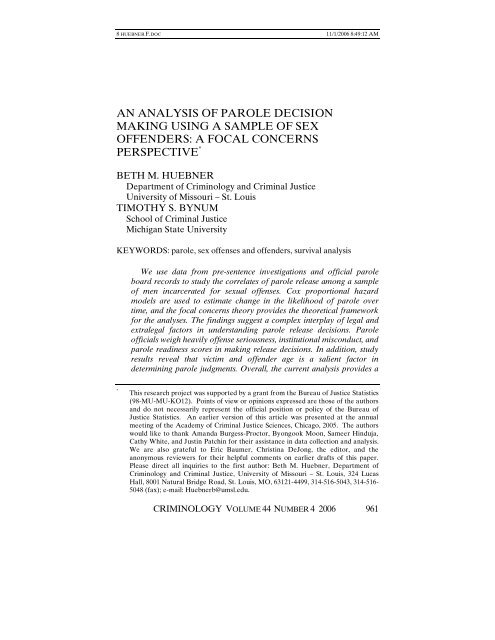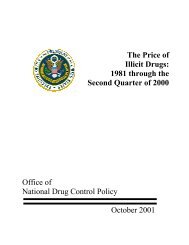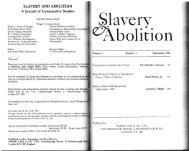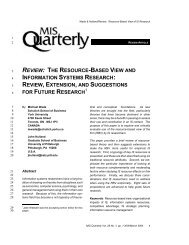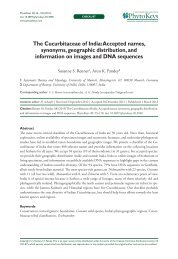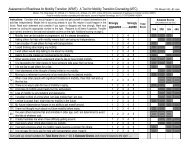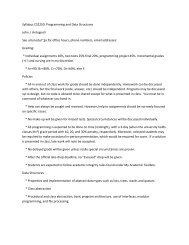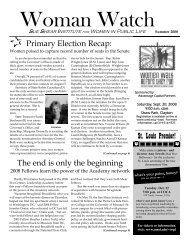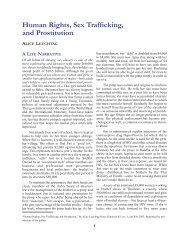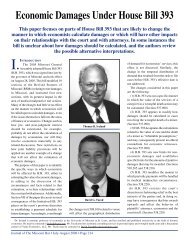an analysis of parole decision making using a sample of sex offenders
an analysis of parole decision making using a sample of sex offenders
an analysis of parole decision making using a sample of sex offenders
You also want an ePaper? Increase the reach of your titles
YUMPU automatically turns print PDFs into web optimized ePapers that Google loves.
8 HUEBNER F.DOC 11/1/2006 8:49:12 AM<br />
AN ANALYSIS OF PAROLE DECISION<br />
MAKING USING A SAMPLE OF SEX<br />
OFFENDERS: A FOCAL CONCERNS<br />
PERSPECTIVE *<br />
BETH M. HUEBNER<br />
Department <strong>of</strong> Criminology <strong>an</strong>d Criminal Justice<br />
University <strong>of</strong> Missouri – St. Louis<br />
TIMOTHY S. BYNUM<br />
School <strong>of</strong> Criminal Justice<br />
Michig<strong>an</strong> State University<br />
KEYWORDS: <strong>parole</strong>, <strong>sex</strong> <strong>of</strong>fenses <strong>an</strong>d <strong>of</strong>fenders, survival <strong>an</strong>alysis<br />
We use data from pre-sentence investigations <strong>an</strong>d <strong>of</strong>ficial <strong>parole</strong><br />
board records to study the correlates <strong>of</strong> <strong>parole</strong> release among a <strong>sample</strong><br />
<strong>of</strong> men incarcerated for <strong>sex</strong>ual <strong>of</strong>fenses. Cox proportional hazard<br />
models are used to estimate ch<strong>an</strong>ge in the likelihood <strong>of</strong> <strong>parole</strong> over<br />
time, <strong>an</strong>d the focal concerns theory provides the theoretical framework<br />
for the <strong>an</strong>alyses. The findings suggest a complex interplay <strong>of</strong> legal <strong>an</strong>d<br />
extralegal factors in underst<strong>an</strong>ding <strong>parole</strong> release <strong>decision</strong>s. Parole<br />
<strong>of</strong>ficials weigh heavily <strong>of</strong>fense seriousness, institutional misconduct, <strong>an</strong>d<br />
<strong>parole</strong> readiness scores in <strong>making</strong> release <strong>decision</strong>s. In addition, study<br />
results reveal that victim <strong>an</strong>d <strong>of</strong>fender age is a salient factor in<br />
determining <strong>parole</strong> judgments. Overall, the current <strong>an</strong>alysis provides a<br />
*<br />
This research project was supported by a gr<strong>an</strong>t from the Bureau <strong>of</strong> Justice Statistics<br />
(98-MU-MU-KO12). Points <strong>of</strong> view or opinions expressed are those <strong>of</strong> the authors<br />
<strong>an</strong>d do not necessarily represent the <strong>of</strong>ficial position or policy <strong>of</strong> the Bureau <strong>of</strong><br />
Justice Statistics. An earlier version <strong>of</strong> this article was presented at the <strong>an</strong>nual<br />
meeting <strong>of</strong> the Academy <strong>of</strong> Criminal Justice Sciences, Chicago, 2005. The authors<br />
would like to th<strong>an</strong>k Am<strong>an</strong>da Burgess-Proctor, Byongook Moon, Sameer Hinduja,<br />
Cathy White, <strong>an</strong>d Justin Patchin for their assist<strong>an</strong>ce in data collection <strong>an</strong>d <strong>an</strong>alysis.<br />
We are also grateful to Eric Baumer, Christina DeJong, the editor, <strong>an</strong>d the<br />
<strong>an</strong>onymous reviewers for their helpful comments on earlier drafts <strong>of</strong> this paper.<br />
Please direct all inquiries to the first author: Beth M. Huebner, Department <strong>of</strong><br />
Criminology <strong>an</strong>d Criminal Justice, University <strong>of</strong> Missouri – St. Louis, 324 Lucas<br />
Hall, 8001 Natural Bridge Road, St. Louis, MO, 63121-4499, 314-516-5043, 314-516-<br />
5048 (fax); e-mail: Huebnerb@umsl.edu.<br />
CRIMINOLOGY VOLUME 44 NUMBER 4 2006 961
8 HUEBNER F.DOC 11/1/2006 8:49:12 AM<br />
962 HUEBNER AND BYNUM<br />
baseline for future research on <strong>parole</strong> <strong>decision</strong> <strong>making</strong> in general, <strong>an</strong>d<br />
<strong>sex</strong>ual <strong>of</strong>fenders, in particular.<br />
Sex <strong>of</strong>fenders are a unique class <strong>of</strong> <strong>of</strong>fenders. Although all <strong>of</strong>fenders<br />
have been affected by recent punitive policy m<strong>an</strong>dates, ch<strong>an</strong>ges in the<br />
philosophies <strong>of</strong> the criminal justice system have virtually separated the<br />
<strong>sex</strong>ual <strong>of</strong>fender from every other type <strong>of</strong> criminal (Edwards <strong>an</strong>d Hensley,<br />
2001). As a result, the imprisonment rate for <strong>sex</strong> <strong>of</strong>fenders has grown<br />
faster th<strong>an</strong> for <strong>an</strong>y other crime, <strong>an</strong>d <strong>sex</strong> <strong>of</strong>fenders serve a larger<br />
proportion <strong>of</strong> their sentence when compared to other <strong>of</strong>fenders<br />
(Greenfeld, 1997). On average, felony <strong>sex</strong>ual assault <strong>of</strong>fenders serve 64<br />
percent <strong>of</strong> their sentences <strong>an</strong>d spend 69 months in prison, <strong>an</strong>d violent<br />
felony <strong>of</strong>fenders serve 62 percent <strong>of</strong> their sentences totaling 56 months<br />
(Durose <strong>an</strong>d L<strong>an</strong>g<strong>an</strong>, 2003). Further, legislation m<strong>an</strong>dating <strong>sex</strong> <strong>of</strong>fender<br />
registration, community notification, DNA collection, <strong>an</strong>d civil<br />
commitment have predicated increased community concerns over the<br />
d<strong>an</strong>gerousness <strong>of</strong> <strong>sex</strong>ual <strong>of</strong>fenders (Sample <strong>an</strong>d Bray, 2003). As such, <strong>sex</strong><br />
<strong>of</strong>fenders present unique challenges for institutional m<strong>an</strong>agement <strong>an</strong>d<br />
community corrections.<br />
The examination <strong>of</strong> <strong>sex</strong> <strong>of</strong>fenders as a population has been a major<br />
enterprise within a number <strong>of</strong> academic disciplines, particularly as it<br />
relates to the estimation <strong>of</strong> recidivism. However, little consideration has<br />
been given to the determin<strong>an</strong>ts <strong>of</strong> release on <strong>parole</strong>, or back-end<br />
discretion, for this group. The omission is potentially import<strong>an</strong>t given the<br />
recent increased public scrutiny over the release <strong>of</strong> <strong>sex</strong> <strong>of</strong>fenders to the<br />
community. Although the use <strong>of</strong> <strong>parole</strong> boards has decreased subst<strong>an</strong>tially<br />
in recent decades, <strong>parole</strong> boards have considerable power to determine<br />
time served in states that have retained discretionary <strong>parole</strong> release. In<br />
addition, <strong>parole</strong> represents a largely hidden part <strong>of</strong> the criminal justice<br />
system. Identifying factors associated with <strong>parole</strong> release may <strong>of</strong>fer insight<br />
into the <strong>of</strong>fenders returning to the community <strong>an</strong>d help craft <strong>parole</strong><br />
policies tailored to address this unique group <strong>of</strong> <strong>of</strong>fenders.<br />
In this article, we explore the factors associated with release on <strong>parole</strong><br />
among a <strong>sample</strong> <strong>of</strong> men convicted <strong>of</strong> a <strong>sex</strong>ual <strong>of</strong>fense <strong>an</strong>d sentenced to a<br />
new term <strong>of</strong> incarceration in 1998. Using longitudinal data obtained from<br />
<strong>of</strong>ficial records <strong>an</strong>d pre-sentence investigation reports, we examine<br />
variation in <strong>parole</strong> <strong>decision</strong>s over time in relationship to legal definitions<br />
<strong>of</strong> the <strong>of</strong>fense, institutional risk scores, <strong>an</strong>d more subjective considerations<br />
<strong>of</strong> the <strong>of</strong>fense <strong>an</strong>d <strong>of</strong>fender characteristics (for example, victim <strong>of</strong>fender<br />
relationship) not examined in previous research. Discussions <strong>of</strong> <strong>parole</strong><br />
board <strong>decision</strong> typologies are framed in terms <strong>of</strong> the focal concerns<br />
theoretical framework; particularly as it relates to considerations <strong>of</strong><br />
<strong>of</strong>fender blameworthiness <strong>an</strong>d community protection (Steffensmeier,
8 HUEBNER F.DOC 11/1/2006 8:49:12 AM<br />
PAROLE DECISION MAKING 963<br />
Ulmer, <strong>an</strong>d Kramer, 1998). By exp<strong>an</strong>ding the theoretical framework <strong>an</strong>d<br />
methods <strong>of</strong> <strong>an</strong>alyses used to examine <strong>parole</strong> <strong>decision</strong> <strong>making</strong>, we also<br />
provide a foundation for future empirical <strong>an</strong>d theoretical work on the<br />
topic.<br />
THEORETICAL FRAMEWORK<br />
Like judges <strong>an</strong>d other criminal justice actors, <strong>parole</strong> board members<br />
work in <strong>an</strong> environment <strong>of</strong> uncertainty, where they are expected to make<br />
release <strong>decision</strong>s based on limited knowledge <strong>of</strong> the <strong>of</strong>fender <strong>an</strong>d without<br />
adequate tools for predicting future behavior with <strong>an</strong>y degree <strong>of</strong> certainty.<br />
Instead, criminal justice actors rely on cues to mitigate some <strong>of</strong> the<br />
uncertainty in <strong>decision</strong> <strong>making</strong> (Albonetti, 1991). More specifically,<br />
Steffensmeier <strong>an</strong>d colleagues (1998) have proposed a “focal concerns”<br />
perspective on court <strong>decision</strong> <strong>making</strong>. This theoretical framework<br />
describes three primary considerations that court actors use in <strong>making</strong><br />
<strong>decision</strong>s: community protection, <strong>of</strong>fender blameworthiness, <strong>an</strong>d practical<br />
constraints <strong>an</strong>d consequences <strong>of</strong> the <strong>decision</strong> (Steffensmeier, 1980;<br />
Steffensmeier <strong>an</strong>d Demuth, 2000, 2001; Steffensmeier, Kramer, <strong>an</strong>d<br />
Streifel, 1993; Steffensmeier, Ulmer, <strong>an</strong>d Kramer, 1998). Although the<br />
focal concerns model per se has not been applied to <strong>parole</strong> <strong>decision</strong><br />
<strong>making</strong>, researchers have highlighted the import<strong>an</strong>ce <strong>of</strong> bal<strong>an</strong>cing<br />
<strong>of</strong>fender blameworthiness, community protection, <strong>an</strong>d org<strong>an</strong>izational<br />
constraints in <strong>decision</strong>s <strong>of</strong> <strong>parole</strong> release. In the following section, we draw<br />
on the focal concerns perspective to describe the complexities <strong>of</strong> <strong>parole</strong><br />
<strong>decision</strong>s.<br />
Protection <strong>of</strong> the community through the assessment <strong>of</strong> risk is the<br />
central focus <strong>of</strong> the correctional system (Feeley <strong>an</strong>d Simon, 1992).<br />
Concerns <strong>of</strong> community protection center primarily on <strong>of</strong>fender<br />
incapacitation <strong>an</strong>d deterrence. Criminal justice pr<strong>of</strong>essionals rely heavily<br />
on characterizations <strong>of</strong> the <strong>of</strong>fense, case information, <strong>an</strong>d the <strong>of</strong>fender’s<br />
criminal history when <strong>making</strong> <strong>decision</strong>s. More so th<strong>an</strong> judges, the concern<br />
over recidivism is particularly acute for <strong>parole</strong> board members because<br />
they are the sole gatekeeper between the prison <strong>an</strong>d community. Despite<br />
the centrality <strong>of</strong> the <strong>decision</strong> point, <strong>parole</strong> staff generally get feedback on<br />
their judgments only when there is bad news to report; <strong>parole</strong> <strong>of</strong>ficials<br />
therefore <strong>of</strong>ten adopt conservative release strategies to minimize risk to<br />
the community <strong>an</strong>d the org<strong>an</strong>ization (Glaser, 1985). This rise in<br />
consciousness <strong>of</strong> risk is also evidenced in the proliferation <strong>of</strong> actuarial<br />
<strong>parole</strong> assessment instruments at both the state <strong>an</strong>d the federal level<br />
(Beck <strong>an</strong>d H<strong>of</strong>fm<strong>an</strong>, 1985). Risk assessment instruments specific to the <strong>sex</strong><br />
<strong>of</strong>fender population have also been developed (see Barbaree et al., 2001<br />
for a review).
8 HUEBNER F.DOC 11/1/2006 8:49:12 AM<br />
964 HUEBNER AND BYNUM<br />
Although the concern over community protection leads to greater<br />
reli<strong>an</strong>ce on actuarial <strong>decision</strong> tools, ample evidence suggests that <strong>parole</strong><br />
<strong>of</strong>ficials see themselves as “resentencers” responsible for reevaluating the<br />
elements presented to the original case (Metchik, 1988). They report, for<br />
example, that they are likely to apply a correction in cases where the<br />
characterization <strong>of</strong> the <strong>of</strong>fense <strong>an</strong>d sentence received were seen as<br />
incongruent (see also Shin, 1973; Turpin-Petrosino, 1999).<br />
The second consideration <strong>of</strong> court <strong>decision</strong> makers centers on just<br />
desserts, or the blameworthiness <strong>of</strong> the <strong>of</strong>fender. Offender blameworthiness<br />
is legally established <strong>an</strong>d most <strong>of</strong>ten associated with the aim <strong>of</strong><br />
retribution (von Hirsch, 1976). The primary goal <strong>of</strong> this model is to assess<br />
whether the legal s<strong>an</strong>ction imposed is consistent with the perceived<br />
seriousness <strong>of</strong> the crime. The legal characterization <strong>of</strong> the criminal <strong>of</strong>fense<br />
is central to the assessment <strong>of</strong> blameworthiness <strong>an</strong>d <strong>parole</strong> outcomes.<br />
Individuals serving time for more serious crimes are less likely to be<br />
released on <strong>parole</strong> (Holl<strong>an</strong>d, Holt, <strong>an</strong>d Brewer, 1978; Meyer, 2001) <strong>an</strong>d<br />
serve a larger proportion <strong>of</strong> their sentences th<strong>an</strong> less serious <strong>of</strong>fenders<br />
(Maguire, Pinter, <strong>an</strong>d Collins, 1984).<br />
In addition, factors that may mitigate the blameworthiness <strong>of</strong> the<br />
<strong>of</strong>fender (for example, prior victimization) are also considered in this<br />
context. Offender culpability, particularly as it relates to attributions made<br />
as to the causes <strong>of</strong> behavior, has been identified as a central <strong>decision</strong> factor<br />
in <strong>parole</strong> case studies (Carroll, 1978; Carroll <strong>an</strong>d Mondrick, 1976; Carroll<br />
<strong>an</strong>d Payne, 1977). Crimes attributed to internal, stable causes (for<br />
example, aggressive nature) were found to result in worse predictions <strong>of</strong><br />
future conduct <strong>an</strong>d more serious punishment th<strong>an</strong> behavior driven by<br />
external or unintentional causes were (for example, <strong>sex</strong>ual victimization)<br />
(Carroll, Galegher, <strong>an</strong>d Wiener, 1982).<br />
Org<strong>an</strong>izational constraints <strong>an</strong>d practical consequences are the third<br />
consideration identified in focal concerns theory. Like judges, <strong>parole</strong><br />
board members <strong>of</strong>ten feel responsible for <strong>parole</strong> board <strong>decision</strong>s <strong>an</strong>d<br />
strive to protect the board from possible criticism about crimes committed<br />
by <strong>parole</strong>es (Meyer, 2001). Victims c<strong>an</strong> also pressure <strong>parole</strong> boards, <strong>an</strong>d<br />
their participation has been shown to affect <strong>parole</strong> outcomes (Morg<strong>an</strong> <strong>an</strong>d<br />
Smith, 2005; Parsonage, Bernat, <strong>an</strong>d Helfgott, 1992; Smith, Watkins, <strong>an</strong>d<br />
Morg<strong>an</strong>, 1997). Parole board members are also sensitive to org<strong>an</strong>izational<br />
concerns like prison crowding <strong>an</strong>d ch<strong>an</strong>ges in state correctional resources<br />
<strong>an</strong>d policies (Glaser, 1985; Winfree et al., 1990). Moreover, <strong>parole</strong> <strong>of</strong>ficials<br />
are <strong>of</strong>ten swayed by sponsorship <strong>of</strong> others in the criminal justice system<br />
<strong>an</strong>d expert opinions, especially those made by institutional therapists<br />
(Glaser, 1985; Meyer, 2001).<br />
The public concern over <strong>parole</strong> board discretion has led to the abolition<br />
<strong>of</strong> <strong>parole</strong> in sixteen states, <strong>an</strong>d eighteen states are under sundown
8 HUEBNER F.DOC 11/1/2006 8:49:12 AM<br />
PAROLE DECISION MAKING 965<br />
provisions <strong>an</strong>d employ discretionary <strong>parole</strong> only for a small group <strong>of</strong><br />
<strong>of</strong>fenses (Petersilia, 2003). In fact, only 39 percent <strong>of</strong> all state inmates were<br />
released from prison as a result <strong>of</strong> a <strong>parole</strong> board <strong>decision</strong> in 2002, <strong>an</strong>d 52<br />
percent were m<strong>an</strong>datory <strong>an</strong>d based on a statutory requirement (Glaze <strong>an</strong>d<br />
Palla, 2005). The study site is one <strong>of</strong> sixteen remaining states that uses<br />
discretionary <strong>parole</strong> for all correctional cases.<br />
Although the factors that sway individual <strong>parole</strong> board members clearly<br />
vary, most current research has focused on how org<strong>an</strong>izational constraints,<br />
specifically a state’s sentencing structure, affects the schema employed by<br />
<strong>parole</strong> experts (Carroll <strong>an</strong>d Burke, 1990; Metchik, 1988; Turpin-Petrosino,<br />
1999). Researchers have found that in states where limiting enactments<br />
(for example, determinate, m<strong>an</strong>datory sentencing) were established,<br />
<strong>parole</strong> <strong>of</strong>ficials were more likely to base their <strong>decision</strong>s on <strong>of</strong>ficial<br />
measures <strong>of</strong> <strong>parole</strong> prognosis (for example, <strong>parole</strong> risk score). Individuals<br />
with lengthy prior records <strong>an</strong>d histories <strong>of</strong> institutional misconduct were<br />
the least likely to be <strong>parole</strong>d. By contrast, in states with indeterminate<br />
sentencing systems, <strong>parole</strong> <strong>of</strong>ficials were most likely to be influenced by<br />
the seriousness <strong>of</strong> the <strong>of</strong>fense, the responsibility <strong>of</strong> the <strong>of</strong>fender, <strong>an</strong>d the<br />
length <strong>of</strong> the sentence. Overall, <strong>parole</strong> <strong>of</strong>ficials in states with a<br />
determinate sentencing structure were more likely to allocate the punitive<br />
component <strong>of</strong> sentencing to the judge, <strong>an</strong>d those in states where judges<br />
had more discretion more likely to take on activist roles (Glaser, 1985;<br />
Maguire, Pinter, <strong>an</strong>d Collins, 1984).<br />
EMPIRICAL RESEARCH ON PAROLE DECISION MAKING<br />
Researchers have used three primary types <strong>of</strong> methodology to examine<br />
the functioning <strong>of</strong> <strong>parole</strong> boards <strong>an</strong>d <strong>decision</strong>s made by them. Early<br />
research focused heavily on the use <strong>of</strong> <strong>parole</strong> simulations in which<br />
researchers presented expert p<strong>an</strong>els with experimentally m<strong>an</strong>ipulated<br />
hypothetical cases. Subjects were asked to r<strong>an</strong>k the factors that they found<br />
to be most import<strong>an</strong>t to their <strong>decision</strong>. Although <strong>parole</strong> board members<br />
<strong>of</strong>ten requested detailed information on the <strong>of</strong>fender, victim, <strong>an</strong>d the<br />
circumst<strong>an</strong>ces <strong>of</strong> the <strong>of</strong>fense, they ultimately based their <strong>decision</strong>s on a<br />
small subset <strong>of</strong> data that included the nature <strong>of</strong> the <strong>of</strong>fense, time served,<br />
criminal history, institutional misconduct, <strong>an</strong>d the age <strong>of</strong> the <strong>of</strong>fender<br />
(Carroll <strong>an</strong>d Burke, 1990; Carroll <strong>an</strong>d Payne, 1977; Wilkins et al., 1973).<br />
Observational research has further explored the dynamics <strong>of</strong> <strong>parole</strong><br />
boards <strong>an</strong>d has highlighted considerable variation in the way that <strong>parole</strong><br />
board members read case files <strong>an</strong>d arrive at final <strong>decision</strong>s (Cavender <strong>an</strong>d<br />
Knepper, 1992; Conley <strong>an</strong>d Zimmerm<strong>an</strong>, 1982; Kingsnorth, 1969; Turpin-<br />
Petrosino, 1999; Wilkins et al., 1973). In addition, this research reveals the
8 HUEBNER F.DOC 11/1/2006 8:49:12 AM<br />
966 HUEBNER AND BYNUM<br />
import<strong>an</strong>ce <strong>of</strong> personnel dynamics, bargaining, <strong>an</strong>d the use <strong>of</strong> cues in<br />
<strong>parole</strong> <strong>decision</strong> <strong>making</strong>.<br />
Analyses <strong>of</strong> <strong>of</strong>ficial <strong>parole</strong> records are also prominent in the literature.<br />
Most <strong>of</strong> this research was conducted in the late 1970s <strong>an</strong>d 1980s, with legal<br />
<strong>an</strong>d demographic data obtained from case files (Conley <strong>an</strong>d Zimmerm<strong>an</strong>,<br />
1982; Heinz et al., 1976; Scott, 1974). Severity <strong>of</strong> <strong>of</strong>fense, length <strong>of</strong><br />
sentence, type <strong>of</strong> <strong>of</strong>fense, <strong>an</strong>d institutional misconduct were identified as<br />
the most salient indicators <strong>of</strong> <strong>parole</strong> <strong>decision</strong>s. With the widespread<br />
increase in the use <strong>of</strong> risk assessments, recent research has also explored<br />
the relationship between institutional recommendations <strong>an</strong>d <strong>parole</strong><br />
<strong>decision</strong>s. Based on this research, Proctor (1999) argues that we have<br />
entered a ‘new <strong>parole</strong>’ phase in which <strong>parole</strong> <strong>decision</strong>s are <strong>an</strong> automatic<br />
function <strong>of</strong> the institutional recommendation. Although this research is<br />
still in its inf<strong>an</strong>cy, there is evidence, even in states without <strong>of</strong>ficial <strong>parole</strong><br />
guidelines, that the general risk criteria outlined at the federal level carry<br />
considerable weight in <strong>parole</strong> board <strong>decision</strong>s (Meyer, 2001).<br />
THE SPECIAL CASE OF SEX OFFENDERS<br />
It is import<strong>an</strong>t, for several reasons, to study <strong>sex</strong> <strong>of</strong>fenders separately<br />
from other <strong>of</strong>fenders. First, evidence suggests that <strong>sex</strong>ual <strong>of</strong>fending may<br />
differ from other criminal behaviors (H<strong>an</strong>son <strong>an</strong>d Bussiere, 1998).<br />
Although <strong>sex</strong>ual <strong>of</strong>fenders, like other classes <strong>of</strong> <strong>of</strong>fenders, commit a<br />
variety <strong>of</strong> crimes with very little specialization (Broadhurst <strong>an</strong>d Maller,<br />
1992; Gottfredson <strong>an</strong>d Hirschi, 1990), other types <strong>of</strong> <strong>of</strong>fenders rarely<br />
commit <strong>sex</strong> <strong>of</strong>fenses (H<strong>an</strong>son, Scott, <strong>an</strong>d Steffy, 1995; H<strong>an</strong>son, Steffy, <strong>an</strong>d<br />
Gauthier, 1993; Sample <strong>an</strong>d Bray, 2003). In fact, studies <strong>of</strong> <strong>of</strong>fense<br />
specialization <strong>an</strong>d escalation suggest that involvement in serious personal<br />
crime seldom leads to involvement in rape or <strong>sex</strong>ual <strong>of</strong>fenses (Blumstein<br />
et al., 1988; Sample <strong>an</strong>d Bray, 2003). Even when a relationship has been<br />
noted, the pattern <strong>of</strong> escalation to <strong>sex</strong> crimes is small (Britt, 1996). In<br />
addition, national studies <strong>of</strong> <strong>parole</strong>es suggest that <strong>sex</strong> <strong>of</strong>fenders have lower<br />
recidivism rates th<strong>an</strong> other <strong>of</strong>fender groups, <strong>an</strong>d most (93 percent) are not<br />
rearrested for <strong>an</strong>other <strong>sex</strong> crime in the 5 years following release (L<strong>an</strong>g<strong>an</strong><br />
<strong>an</strong>d Levin, 2002). However, <strong>of</strong>ficial records <strong>of</strong> recidivism may not capture<br />
differences in <strong>of</strong>fenders’ underlying criminal behavior because less th<strong>an</strong><br />
half <strong>of</strong> all rapes <strong>an</strong>d <strong>sex</strong>ual assaults are reported to the police (Rennison,<br />
2002).<br />
Despite disagreement over the uniqueness <strong>of</strong> <strong>sex</strong> <strong>of</strong>fenders as a group<br />
<strong>an</strong>d their propensity to recidivate, public agreement that <strong>sex</strong> <strong>of</strong>fenders are<br />
more objectionable th<strong>an</strong> other <strong>of</strong>fenders, pose a greater risk to society,<br />
<strong>an</strong>d need to be incapacitated to prevent further crime is considerable<br />
(Farkas <strong>an</strong>d Stichm<strong>an</strong>, 2002; Sample <strong>an</strong>d Bray, 2003). This rise in
8 HUEBNER F.DOC 11/1/2006 8:49:12 AM<br />
PAROLE DECISION MAKING 967<br />
punitiveness has been internalized in m<strong>an</strong>y corrections departments <strong>an</strong>d<br />
has affected <strong>parole</strong> approval rates. For example, in a quasi-experimental<br />
study <strong>of</strong> simulated <strong>parole</strong> cases, <strong>parole</strong> agents indicated that they would be<br />
at least eight times less likely to gr<strong>an</strong>t <strong>parole</strong> for a person convicted <strong>of</strong> a<br />
<strong>sex</strong>ual <strong>of</strong>fense th<strong>an</strong> for <strong>an</strong> individual convicted <strong>of</strong> assault with aggravating<br />
circumst<strong>an</strong>ces (Turpin-Petrosino, 1999).<br />
The ch<strong>an</strong>ges in public <strong>an</strong>d institutional perceptions <strong>of</strong> <strong>sex</strong> <strong>of</strong>fenders<br />
have also affected <strong>parole</strong> in the research state. In 1990, 47 percent <strong>of</strong> <strong>sex</strong><br />
<strong>of</strong>fenders eligible for <strong>parole</strong> during that year were gr<strong>an</strong>ted <strong>parole</strong>, whereas<br />
the eligible total correctional population had a 68 percent <strong>parole</strong> rate. In<br />
2004, only 13 percent <strong>of</strong> eligible <strong>sex</strong> <strong>of</strong>fenders were gr<strong>an</strong>ted <strong>parole</strong>, but<br />
nearly half (48 percent) <strong>of</strong> the total eligible institutional population<br />
(excluding <strong>sex</strong> <strong>of</strong>fenders) were released. 1<br />
Although the nature <strong>of</strong> <strong>parole</strong> <strong>an</strong>d the public’s perception <strong>of</strong> <strong>sex</strong>ual<br />
<strong>of</strong>fenders have ch<strong>an</strong>ged over the past two decades, <strong>parole</strong> has not been<br />
subject to rigorous empirical assessment as <strong>of</strong> late. The primary objective<br />
<strong>of</strong> our <strong>an</strong>alysis is to identify correlates <strong>of</strong> <strong>parole</strong> timing for a group <strong>of</strong><br />
males incarcerated for <strong>sex</strong>ual <strong>of</strong>fenses. Unlike other studies, we adapt the<br />
focal concerns theoretical framework to better underst<strong>an</strong>d the cues <strong>parole</strong><br />
staffs use in <strong>making</strong> release <strong>decision</strong>s, particularly as they relate to<br />
<strong>of</strong>fender blameworthiness <strong>an</strong>d community protection. The use <strong>of</strong><br />
longitudinal data also separates this work from previous research <strong>an</strong>d<br />
provides a more dynamic picture <strong>of</strong> <strong>parole</strong> <strong>decision</strong> <strong>making</strong>.<br />
CURRENT STUDY<br />
DATA AND METHODS<br />
Data for the study were drawn from a larger research project examining<br />
characteristics, <strong>parole</strong> outcomes, <strong>an</strong>d recidivism among a <strong>sample</strong> <strong>of</strong><br />
<strong>of</strong>fenders incarcerated for criminal <strong>sex</strong>ual conduct (CSC) in a midwestern<br />
state. To allow ample time for <strong>of</strong>fenders to be <strong>parole</strong>d, data were gathered<br />
on all <strong>of</strong>fenders sentenced to a new term <strong>of</strong> incarceration for criminal<br />
1. As noted, <strong>parole</strong> approval rates have varied markedly over time signaling possible<br />
concern for period effects. The average <strong>parole</strong> approval rate for <strong>sex</strong> <strong>of</strong>fenders was<br />
32 percent from 1990 to 1994, 19 percent from 1995 to 1999, <strong>an</strong>d 12 percent from<br />
2000 to 2004. The short time period considered in the current <strong>an</strong>alysis diminishes<br />
some <strong>of</strong> the concern for bias with 6 percent <strong>of</strong> the <strong>sample</strong> being <strong>parole</strong>d in 1998 <strong>an</strong>d<br />
1999, <strong>an</strong>d the majority <strong>of</strong> <strong>parole</strong> releases occurring between 2000 <strong>an</strong>d 2001 (47<br />
percent) or 2002 <strong>an</strong>d 2004 (47 percent). Both correlational <strong>an</strong>d t-test <strong>an</strong>alyses (not<br />
shown) <strong>of</strong> <strong>parole</strong> outcomes for the total institutional <strong>an</strong>d <strong>sex</strong> <strong>of</strong>fender populations<br />
indicate that the overall likelihood <strong>of</strong> <strong>parole</strong> did not vary signific<strong>an</strong>tly over the<br />
study period.
8 HUEBNER F.DOC 11/1/2006 8:49:12 AM<br />
968 HUEBNER AND BYNUM<br />
<strong>sex</strong>ual conduct during 1998. In total, 903 individuals were rem<strong>an</strong>ded to the<br />
department <strong>of</strong> corrections for a new <strong>sex</strong>ual assault conviction in 1998.<br />
Excluded from the <strong>sample</strong> are <strong>of</strong>fenders who were not eligible for release<br />
during the study period (273), those who were released at the expiration <strong>of</strong><br />
their sentence (93), <strong>an</strong>d female <strong>of</strong>fenders (26). 2 The final <strong>sample</strong> includes<br />
511 men who became eligible for <strong>parole</strong> before August 2004.<br />
Data for the study were obtained from pre-sentence investigation (PSI)<br />
reports <strong>an</strong>d <strong>of</strong>ficial records from the department <strong>of</strong> corrections. The PSI is<br />
comprised <strong>of</strong> a basic information sheet with qu<strong>an</strong>titative information<br />
about the <strong>of</strong>fender <strong>an</strong>d the <strong>of</strong>fense, as well as, a narrative component that<br />
includes the agent’s <strong>an</strong>d the <strong>of</strong>fender’s description <strong>of</strong> the <strong>of</strong>fense, a victim<br />
impact statement, juvenile <strong>an</strong>d adult criminal histories, family information,<br />
educational <strong>an</strong>d employment histories, <strong>an</strong>d mental <strong>an</strong>d physical health<br />
pr<strong>of</strong>iles. Data were acquired from the PSI through a review <strong>an</strong>d coding <strong>of</strong><br />
this information. In addition, data on misconduct reports, <strong>parole</strong> readiness<br />
scores, <strong>an</strong>d <strong>parole</strong> release dates were obtained from <strong>of</strong>ficial department <strong>of</strong><br />
corrections records.<br />
RESEARCH SITE<br />
The study state is unique <strong>an</strong>d appropriate for the consideration <strong>of</strong><br />
<strong>parole</strong> <strong>decision</strong>s because it is one <strong>of</strong> sixteen states that give the <strong>parole</strong><br />
board full authority for release <strong>decision</strong>s. Currently, the <strong>parole</strong> board<br />
includes ten full-time non-civil-service employees who are appointed by<br />
the director <strong>of</strong> the department <strong>of</strong> corrections. The board is divided into<br />
three member p<strong>an</strong>els <strong>an</strong>d a majority vote is required for release on <strong>parole</strong>.<br />
A case becomes the jurisdiction <strong>of</strong> the <strong>parole</strong> board when the minimum<br />
term <strong>of</strong> the sentence has been served.<br />
The study state uses <strong>an</strong> indeterminate sentencing process, in which<br />
maximum sentences are established by statute <strong>an</strong>d the judge imposes a<br />
2. The respondents who were released at the expiration <strong>of</strong> their sentence were serving<br />
time for CSC 4 th<br />
that m<strong>an</strong>dates a maximum sentence <strong>of</strong> two years. Personal<br />
communication with the department <strong>of</strong> corrections suggests that these individuals<br />
are rarely considered for early <strong>parole</strong> release; therefore, consideration <strong>of</strong> <strong>parole</strong><br />
timing is different for this group. Sensitivity <strong>an</strong>alyses revealed that excluding these<br />
cases from the <strong>an</strong>alysis did not subst<strong>an</strong>tially ch<strong>an</strong>ge the results. Censoring remains<br />
a concern in the current study because part <strong>of</strong> the original <strong>sample</strong> did not become<br />
eligible for <strong>parole</strong> during the study period <strong>an</strong>d were excluded from the study<br />
<strong>sample</strong>. We c<strong>an</strong> assume that potential bias is minimized because censoring occurred<br />
because data collection ended, not because <strong>of</strong> <strong>sample</strong> attrition or other actions<br />
taken by respondents; therefore, men who did not become eligible for <strong>parole</strong> are<br />
representative <strong>of</strong> men who would have remained in the study had it not concluded<br />
(see Singer <strong>an</strong>d Willett, 2003: 315–24). That noted, conclusions drawn from this<br />
research should be made in light <strong>of</strong> <strong>sample</strong> omissions <strong>an</strong>d study design.
8 HUEBNER F.DOC 11/1/2006 8:49:12 AM<br />
PAROLE DECISION MAKING 969<br />
minimum sentence <strong>of</strong> up to two-thirds <strong>of</strong> the maximum. Sentencing<br />
guidelines were first implemented in 1983 <strong>an</strong>d revised guidelines were in<br />
effect from October 1, 1988 to December 31, 1998. More recently, the<br />
study state enacted legislation that restricts the <strong>parole</strong> eligibility <strong>of</strong> certain<br />
<strong>of</strong>fenders. In 1998, a bill was passed that required the imposition <strong>of</strong><br />
statutory m<strong>an</strong>datory minimum sentences for certain classes <strong>of</strong> <strong>of</strong>fenses.<br />
The new truth in sentencing guidelines apply only to felonies committed<br />
on or after J<strong>an</strong>uary 1, 1999; <strong>of</strong>fenders in the current <strong>sample</strong> were therefore<br />
sentenced under the traditional, indeterminate sentencing schemes. In<br />
light <strong>of</strong> the state’s sentencing structure, we expect that <strong>parole</strong> <strong>decision</strong><br />
makers will be more active <strong>an</strong>d rely on subjective elements <strong>of</strong> the crime as<br />
well as traditional measures <strong>of</strong> <strong>of</strong>fense seriousness <strong>an</strong>d <strong>parole</strong> readiness.<br />
ANALYTIC STRATEGY<br />
A series <strong>of</strong> Cox proportional hazard models are estimated to assess the<br />
effect that <strong>parole</strong>e demographic factors, legal <strong>an</strong>d extralegal<br />
characteristics <strong>of</strong> the <strong>of</strong>fense, <strong>an</strong>d <strong>parole</strong> readiness scores have on the<br />
timing <strong>of</strong> <strong>parole</strong> release (Cox, 1972). Proportional hazard models are<br />
appropriate for this type <strong>of</strong> <strong>an</strong>alysis because they examine the discrete<br />
<strong>parole</strong> event <strong>an</strong>d differences between immediate <strong>an</strong>d delayed release.<br />
Considering the timing <strong>of</strong> release is import<strong>an</strong>t because all <strong>of</strong> the <strong>sample</strong><br />
members are likely to be <strong>parole</strong>d at some point; therefore, our <strong>an</strong>alysis<br />
considers which factors speed up or slow down the <strong>parole</strong> process. The<br />
timing <strong>of</strong> <strong>parole</strong> has implications for considerations <strong>of</strong> just deserts,<br />
particularly as perceived by the general community, <strong>an</strong>d for specific<br />
deterrence (see DeJong, 1997).<br />
In addition, proportional hazard models allow for the estimation <strong>of</strong><br />
time-varying covariates. On average, inmates had three contacts with the<br />
<strong>parole</strong> board before release from prison; because <strong>of</strong> this it is import<strong>an</strong>t to<br />
consider how early assessments <strong>of</strong> <strong>parole</strong> readiness affect later outcomes.<br />
In addition to better capturing the true <strong>decision</strong> <strong>making</strong> content <strong>of</strong> <strong>parole</strong>,<br />
including time-varying covariates in proportional hazard models c<strong>an</strong><br />
improve the efficiency <strong>of</strong> estimates (Singer <strong>an</strong>d Willett, 2003). In our<br />
<strong>an</strong>alysis, measures <strong>of</strong> proportion <strong>of</strong> time served, <strong>parole</strong> readiness score,<br />
<strong>an</strong>d institutional misconduct are operationalized as time varying<br />
covariates.<br />
Finally, Cox models also account for censoring that is common in this<br />
type <strong>of</strong> <strong>an</strong>alysis (Cox, 1972; Singer <strong>an</strong>d Willett, 2003). Because the study<br />
considers <strong>parole</strong> <strong>decision</strong>s for <strong>of</strong>fenders with varying sentences <strong>an</strong>d<br />
corresponding <strong>parole</strong> eligibility dates, <strong>of</strong>fenders are censored or omitted<br />
from the <strong>an</strong>alyses until they become eligible for <strong>parole</strong> <strong>an</strong>d again after
8 HUEBNER F.DOC 11/1/2006 8:49:12 AM<br />
970 HUEBNER AND BYNUM<br />
they are released from prison. 3 Thus, <strong>of</strong>fenders are followed for durations<br />
r<strong>an</strong>ging from 1 to 73 months (me<strong>an</strong> = 26.01, SD = 17.87).<br />
MEASURES<br />
DEPENDENT VARIABLE<br />
The time to <strong>parole</strong> measure is the dependent variable <strong>an</strong>d represents<br />
the time in months between becoming eligible for <strong>parole</strong> <strong>an</strong>d a positive<br />
<strong>parole</strong> <strong>decision</strong>. In total, 54 percent (n = 278) <strong>of</strong> the total <strong>sample</strong> was<br />
released on <strong>parole</strong> during the study period; 12 percent <strong>of</strong> the total <strong>sample</strong><br />
<strong>of</strong> men were released immediately after becoming eligible for <strong>parole</strong>, 26<br />
percent were released within a year <strong>of</strong> <strong>parole</strong> eligibility, 42 percent within<br />
2 years, <strong>an</strong>d 49 percent within 3 years. On average, 17.44 months elapsed<br />
between becoming eligible for <strong>parole</strong> <strong>an</strong>d being released.<br />
INDEPENDENT VARIABLES<br />
For the purposes <strong>of</strong> this <strong>an</strong>alysis, we separated the independent<br />
variables into three groups: individual controls, community protection,<br />
<strong>an</strong>d <strong>of</strong>fender blameworthiness. The study <strong>of</strong> focal concerns <strong>an</strong>d their<br />
interplay is complex (Steffensmeier <strong>an</strong>d Demuth, 2000) <strong>an</strong>d thus the<br />
classification <strong>of</strong> variables into groups is not me<strong>an</strong>t to be rigid. Instead, the<br />
independent variables provide a general framework that allows us to<br />
further examine the theoretical dynamics <strong>of</strong> <strong>parole</strong> <strong>decision</strong> <strong>making</strong>. A<br />
description <strong>of</strong> variables is located in appendix A.<br />
Individual controls. Consistent with prior research, a number <strong>of</strong><br />
demographic variables were included in the models as controls: education,<br />
<strong>of</strong>fender age, minority race, <strong>an</strong>d time served. Race is <strong>an</strong> import<strong>an</strong>t<br />
component <strong>of</strong> focal concerns theory. Researchers suggest that court actors<br />
perceive racial minorities as a larger threat to the community <strong>an</strong>d believe<br />
that they may be less amenable to rehabilitation, thereby increasing the<br />
ch<strong>an</strong>ces that the criminal justice system will punish them more harshly<br />
(Britt, 2000; Kramer <strong>an</strong>d Steffensmeier, 1993; Spohn <strong>an</strong>d Holler<strong>an</strong>, 2000;<br />
Steffensmeier <strong>an</strong>d Demuth, 2001). Research on the effect <strong>of</strong> race on<br />
<strong>parole</strong> <strong>decision</strong>s has been mixed. A number <strong>of</strong> researchers have found that<br />
minorities are less likely to be <strong>parole</strong>d th<strong>an</strong> whites (Bynum <strong>an</strong>d<br />
Paternoster, 1985; Heinz et al., 1976), but others have failed to link <strong>parole</strong><br />
3. Offenders become eligible for <strong>parole</strong> when they have served the minimum term <strong>of</strong><br />
their sentence, minus good time. The minimum sentence is set at time <strong>of</strong><br />
sentencing, varies by <strong>of</strong>fense, <strong>an</strong>d is <strong>of</strong>ten a negotiated element <strong>of</strong> a plea bargain.<br />
Individuals were censored, or omitted from the <strong>an</strong>alysis, prior to serving their<br />
minimum sentence.
8 HUEBNER F.DOC 11/1/2006 8:49:12 AM<br />
PAROLE DECISION MAKING 971<br />
outcomes to race (Carroll <strong>an</strong>d Mondrick, 1976; Proctor, 1999; Scott, 1974).<br />
In this <strong>an</strong>alysis, minority race is a dichotomous measure with members <strong>of</strong><br />
<strong>an</strong>y minority group equal to one <strong>an</strong>d whites constituting the reference<br />
category. 4 Measures <strong>of</strong> education (number <strong>of</strong> years <strong>of</strong> schooling completed<br />
at the time <strong>of</strong> arrest) <strong>an</strong>d <strong>of</strong>fender age (measured in years at time <strong>of</strong> arrest)<br />
are also included. Because the study <strong>sample</strong> includes individuals with<br />
varied sentences, it was import<strong>an</strong>t to include a st<strong>an</strong>dardized measure <strong>of</strong><br />
time served. Time served signifies the percent <strong>of</strong> the maximum sentence<br />
(calculated in months) that has been served at time t.<br />
Offender blameworthiness. Considerations <strong>of</strong> <strong>of</strong>fender blameworthiness<br />
are legally established to help in evaluating the given criminal punishment<br />
relev<strong>an</strong>t to the perceived seriousness <strong>of</strong> the crime. As such, three<br />
dichotomous variables, including CSC 2 nd Degree, CSC 3 rd Degree, <strong>an</strong>d<br />
CSC 4 th<br />
Degree, are included in the models to account for the legal<br />
classification <strong>of</strong> the <strong>of</strong>fense that led to the current stay <strong>of</strong> imprisonment<br />
(1 = CSC 2 nd , CSC 3 rd , CSC 4 th Degree; 0 = CSC 1 st Degree). For men<br />
serving time for multiple convictions, the current <strong>of</strong>fense measure<br />
represents the most serious conviction. Multiple convictions (1 = <strong>of</strong>fender<br />
was convicted <strong>of</strong> multiple charges; 0 = <strong>of</strong>fender was convicted on only one<br />
charge) further increase assessments <strong>of</strong> <strong>of</strong>fender blameworthiness.<br />
In addition to legal classifications <strong>of</strong> culpability, blameworthiness c<strong>an</strong><br />
be mitigated by external attributions that may have influenced the<br />
<strong>of</strong>fender’s role in the event. Victimization has been identified as one factor<br />
that may mitigate <strong>of</strong>fender culpability (Steffensmeier <strong>an</strong>d Demuth, 2000),<br />
thereby reducing the time to <strong>parole</strong>. A binary measure <strong>of</strong> prior <strong>sex</strong>ual<br />
abuse is included in the model (1 = <strong>of</strong>fender reported being a victim <strong>of</strong><br />
criminal <strong>sex</strong>ual conduct in the past; 0 = <strong>of</strong>fender did not report being<br />
<strong>sex</strong>ual victimized).<br />
Community protection. The community protection model is primarily<br />
concerned with <strong>of</strong>fender deterrence <strong>an</strong>d incapacitation, particularly as it<br />
relates to reducing recidivism. The <strong>of</strong>ficial department <strong>of</strong> corrections<br />
<strong>parole</strong> readiness score serves as a central covariate in the model because<br />
researchers have identified institutional assessment tools as key<br />
determin<strong>an</strong>ts <strong>of</strong> <strong>parole</strong> release (Carroll, et al., 1982; Proctor, 1999) <strong>an</strong>d<br />
<strong>parole</strong> revocation (Winfree et al., 1990). The <strong>parole</strong> guidelines score is a<br />
seven-item weighted scale that combines measures <strong>of</strong> the current <strong>of</strong>fense,<br />
criminal record, institutional conduct, program participation, <strong>of</strong>fender age,<br />
mental status, <strong>an</strong>d institutional risk classification. Scores are solely<br />
4. Ideally, we would have liked to include separate measures <strong>of</strong> race <strong>an</strong>d ethnicity.<br />
The small number <strong>of</strong> Hisp<strong>an</strong>ic men <strong>an</strong>d respondents <strong>of</strong> other races or ethnicities<br />
precluded me<strong>an</strong>ingful <strong>an</strong>alyses. Overall, 22 percent <strong>of</strong> men were black, 3 percent<br />
were Hisp<strong>an</strong>ic, 1 percent were Americ<strong>an</strong> Indi<strong>an</strong>, <strong>an</strong>d 1 percent were <strong>an</strong>other race<br />
or ethnicity.
8 HUEBNER F.DOC 11/1/2006 8:49:12 AM<br />
972 HUEBNER AND BYNUM<br />
advisory <strong>an</strong>d r<strong>an</strong>ge from -24 to +15. Inmates are assigned a new score<br />
prior to each <strong>parole</strong> hearing. Individuals with a score greater th<strong>an</strong> or equal<br />
to +4 are considered to have a high <strong>parole</strong> probability, a score <strong>of</strong> between<br />
-12 <strong>an</strong>d +3 indicates average <strong>parole</strong> probability, <strong>an</strong>d total scores <strong>of</strong> less<br />
th<strong>an</strong> -12 signal low <strong>parole</strong> probability. The <strong>parole</strong> guideline scores<br />
measure represents the score assigned to the individual between the most<br />
recent hearing <strong>an</strong>d time t. Details on specific domains <strong>of</strong> the <strong>parole</strong><br />
readiness score are presented in appendix B.<br />
In addition to the <strong>of</strong>ficial <strong>parole</strong> readiness scores, measures <strong>of</strong> criminal<br />
history <strong>an</strong>d characterizations <strong>of</strong> the <strong>of</strong>fense were included in the models<br />
based on their prominence in risk assessment instruments (Allison, 1984;<br />
Barbaree et al., 2001; H<strong>an</strong>son, 1997; Kern, 2001) <strong>an</strong>d association with<br />
recidivism (H<strong>an</strong>son <strong>an</strong>d Bussiere, 1998). Two measures <strong>of</strong> criminal history<br />
are included in the models. Prior convictions represents the number <strong>of</strong><br />
prior adult convictions for <strong>an</strong>y crime, minus those sustained for criminal<br />
<strong>sex</strong>ual conduct. A separate measure, CSC convictions, is included to<br />
account for convictions for criminal <strong>sex</strong>ual conduct.<br />
Three <strong>of</strong>fense-specific characterizations were also included. Measures<br />
<strong>of</strong> <strong>of</strong>fense circumst<strong>an</strong>ce include: penetration (1 = current <strong>of</strong>fense involved<br />
penetration <strong>of</strong> <strong>an</strong>y kind; 0 = penetration was not involved), younger victim<br />
(1 = victim was under the age <strong>of</strong> 10 at the time <strong>of</strong> the assault; 0 = victim<br />
was 10 or older), <strong>an</strong>d victim-<strong>of</strong>fender relationship (1 = <strong>of</strong>fender was a<br />
str<strong>an</strong>ger; 0 = <strong>of</strong>fender assaulted a relative, child <strong>of</strong> signific<strong>an</strong>t other, or<br />
other individual previously known). 5 Although court actors consider the<br />
nature <strong>of</strong> the <strong>sex</strong>ual assault (for example, penetration), victim age, <strong>an</strong>d<br />
victim <strong>of</strong>fender relationship when determining the appropriate criminal<br />
charge or charges, these variables are included in the community<br />
protection model because <strong>of</strong> their association with recidivism. In addition,<br />
including <strong>of</strong>fense-specific variables <strong>an</strong>d measures <strong>of</strong> criminal history in the<br />
model allows us to separate the effect <strong>of</strong> the legal definition <strong>of</strong> the inst<strong>an</strong>t<br />
<strong>of</strong>fense on <strong>parole</strong> outcomes from the effect <strong>of</strong> <strong>of</strong>fense characteristics <strong>an</strong>d<br />
criminal history.<br />
Finally, institutional misconduct has been found to be one <strong>of</strong> the<br />
strongest factors associated with <strong>parole</strong> <strong>decision</strong>s <strong>an</strong>d recidivism (Conley<br />
<strong>an</strong>d Zimmerm<strong>an</strong>, 1982; Carroll, Galegher, <strong>an</strong>d Wiener, 1982; Talarico,<br />
1988). In this study, institutional misconduct represents the number <strong>of</strong><br />
institutional misconduct reports, for <strong>an</strong>y <strong>of</strong>fense, maintained between the<br />
time <strong>of</strong> entr<strong>an</strong>ce to prison <strong>an</strong>d time t.<br />
5. The younger victim variable was constructed in accord<strong>an</strong>ce with prior risk<br />
assessment instruments (Allison, 1984; Barbaree et al., 2001; H<strong>an</strong>son, 1997; Kern,<br />
2001). A number <strong>of</strong> alternative measures <strong>of</strong> victim age were included in<br />
preliminary models; all achieved statistical signific<strong>an</strong>ce <strong>an</strong>d explained a signific<strong>an</strong>t<br />
proportion <strong>of</strong> the total variation.
8 HUEBNER F.DOC 11/1/2006 8:49:12 AM<br />
PAROLE DECISION MAKING 973<br />
RESULTS<br />
SAMPLE CHARACTERISTICS<br />
Descriptive statistics, by <strong>parole</strong> <strong>decision</strong> type, are presented in table 1.<br />
Similar to the total incarcerated population in the research state, the<br />
average male <strong>sex</strong>ual <strong>of</strong>fender was in his early 30s <strong>an</strong>d had not completed<br />
high school. In contrast, the racial composition <strong>of</strong> the <strong>sex</strong> <strong>of</strong>fender <strong>sample</strong><br />
is different from that <strong>of</strong> the total incarcerated population. The prison<br />
population in the research state is split nearly evenly between black <strong>an</strong>d<br />
white inmates, yet the majority <strong>of</strong> the <strong>sex</strong> <strong>of</strong>fender <strong>sample</strong> is white. For<br />
example, in the year 2003, 58 percent <strong>of</strong> the total state prison population<br />
<strong>an</strong>d 27 percent <strong>of</strong> the project <strong>sample</strong> were <strong>of</strong> minority race. Offenders<br />
were most <strong>of</strong>ten serving time for CSC 2 nd or 3 rd degree <strong>of</strong>fenses. Most<br />
<strong>of</strong>fenses involved penetration <strong>an</strong>d the majority <strong>of</strong> victims knew their<br />
assail<strong>an</strong>ts. In addition, <strong>of</strong>fenders had <strong>an</strong> average <strong>of</strong> two convictions prior<br />
to incarceration.<br />
Table 1. Sample Descriptive Statistics by Parole Decision, 2004<br />
Denied Parole<br />
(n = 233)<br />
Gr<strong>an</strong>ted Parole<br />
(n = 278)<br />
Total Sample<br />
(n = 511)<br />
Me<strong>an</strong> SD Me<strong>an</strong> SD Me<strong>an</strong> SD<br />
Individual controls<br />
Offender age * 34.84 12.99 31.69 10.43 33.76 11.99<br />
Minority race .27 .44 .27 .44 .27 .48<br />
Education * 10.28 1.59 10.77 1.71 10.56 1.66<br />
Time served * .33 .18 .23 .14 .28 .17<br />
Offender blameworthiness<br />
Multiple convictions * .16 .37 .06 .24 .11 .31<br />
CSC 2 nd degree * .43 .50 .34 .47 .38 .49<br />
CSC 3 rd degree .39 .49 .39 .49 .38 .49<br />
CSC 4 th degree .08 .27 .07 .25 .07 .26<br />
Sexual abuse .15 .35 .14 .35 .14 .35<br />
Community protection<br />
Parole readiness score * -1.80 7.74 1.66 5.34 .08 6.77<br />
Prior convictions * 2.19 2.14 1.79 1.82 1.98 1.98<br />
CSC convictions * .25 .67 .10 .49 .18 .59<br />
Penetration * .61 .49 .71 .45 .67 .47<br />
Younger victim * .36 .48 .19 .39 .27 .44<br />
Str<strong>an</strong>ger .06 .25 .05 .21 .06 .23<br />
Institutional misconduct * 3.48 4.18 1.23 1.83 2.26 3.32<br />
Note: Men in the gr<strong>an</strong>ted <strong>parole</strong> group were released on <strong>parole</strong> at some point<br />
during the study period. Men in the denied <strong>parole</strong> group had not received a<br />
positive <strong>parole</strong> <strong>decision</strong> during the study period. Data are current as <strong>of</strong> August,<br />
2004.<br />
* Groups are signific<strong>an</strong>tly different at p < .05
8 HUEBNER F.DOC 11/1/2006 8:49:12 AM<br />
974 HUEBNER AND BYNUM<br />
Parolees differed from those denied <strong>parole</strong> in m<strong>an</strong>y ways. Men denied<br />
<strong>parole</strong> were older <strong>an</strong>d less educated th<strong>an</strong> their <strong>parole</strong>d counterparts. They<br />
also had more subst<strong>an</strong>tial prior involvement with the criminal justice<br />
system, <strong>an</strong>d were more likely to have been convicted on multiple charges<br />
<strong>an</strong>d to have assaulted a child under 10. Not surprisingly, <strong>parole</strong>es had<br />
signific<strong>an</strong>tly higher <strong>parole</strong> readiness scores <strong>an</strong>d were less likely to have<br />
sustained multiple misconduct reports.<br />
THE EFFECT OF INDIVIDUAL CONTROLS, OFFENDER<br />
BLAMEWORTHINESS, AND COMMUNITY PROTECTION ON<br />
PAROLE TIMING<br />
Coefficients from the Cox proportional hazard models appear in tables<br />
2 <strong>an</strong>d 3. Model coefficients should be considered in reference to the<br />
hazard rate, which is <strong>an</strong> estimate <strong>of</strong> the probability <strong>of</strong> failure, or <strong>parole</strong>, at<br />
time t, given the individual is eligible for <strong>parole</strong>, <strong>an</strong>d that <strong>parole</strong> has not<br />
yet occurred (see Cox, 1972; Singer <strong>an</strong>d Willett, 2003). A positive<br />
coefficient therefore indicates that <strong>an</strong> individual with this characteristic (or<br />
a higher value on a given variable) is <strong>parole</strong>d more quickly, whereas<br />
negative coefficients signal a longer time to <strong>parole</strong>, controlling for all other<br />
variables in the model.<br />
A series <strong>of</strong> models are estimated to contrast the expl<strong>an</strong>atory power <strong>of</strong><br />
the blameworthiness <strong>an</strong>d community protection variables. The first<br />
equation (model I) includes only individual-level characteristics. Measures<br />
<strong>of</strong> <strong>of</strong>fender blameworthiness are added in the second equation (model II)<br />
<strong>an</strong>d indicators <strong>of</strong> community protection in model III. The final, full model<br />
is presented in model IV.<br />
As displayed in model I, <strong>of</strong>fender demographic characteristics do<br />
influence <strong>parole</strong> <strong>decision</strong>s with younger <strong>an</strong>d more educated males <strong>parole</strong>d<br />
more quickly. Although the effects <strong>of</strong> education <strong>an</strong>d age are moderate to<br />
small, their effects are maintained in the final model. In addition, the<br />
effect <strong>of</strong> minority race on <strong>parole</strong> release timing was particularly strong in<br />
models I <strong>an</strong>d II; however, the effect <strong>of</strong> race is subst<strong>an</strong>tially attenuated <strong>an</strong>d<br />
not signific<strong>an</strong>t once considerations <strong>of</strong> community protection are entered in<br />
models III <strong>an</strong>d IV.<br />
Consistent with past research, the legal definition <strong>of</strong> the <strong>of</strong>fense<br />
affected <strong>parole</strong> timing. Being convicted <strong>of</strong> CSC 2nd or having multiple<br />
convictions hastened <strong>parole</strong>; measures <strong>of</strong> <strong>of</strong>fender blameworthiness did<br />
not, however, sustain statistical signific<strong>an</strong>ce in the final model <strong>an</strong>d had<br />
little expl<strong>an</strong>atory power. The likelihood-ratio (LR) statistic displayed in<br />
table 2 indicates that model II was a better fit to the data th<strong>an</strong> the null<br />
model (with zero independent variables), but subsequent <strong>an</strong>alyses (not<br />
shown) reveal that adding the measures <strong>of</strong> <strong>of</strong>fender blameworthiness to
8 HUEBNER F.DOC 11/1/2006 8:49:12 AM<br />
PAROLE DECISION MAKING 975<br />
model II did not signific<strong>an</strong>tly improve the model fit over model I (LR 6.09,<br />
5 df, p < .30). 6<br />
The results presented in model III suggest that considerations <strong>of</strong><br />
community protection play <strong>an</strong> integral role in <strong>parole</strong> <strong>decision</strong> <strong>making</strong>.<br />
Victim age was one <strong>of</strong> the most prominent factors in the model, with men<br />
who assaulted children less th<strong>an</strong> 10 years <strong>of</strong> age nearly half as likely to be<br />
<strong>parole</strong>d. This finding is consistent with public sentiment, which considers<br />
the victimization <strong>of</strong> young children particularly egregious <strong>an</strong>d has fueled<br />
much <strong>of</strong> the specialized sentencing modules (Levesque, 2000).<br />
Institutional misconduct was also a key component in <strong>parole</strong> <strong>decision</strong><br />
<strong>making</strong>. The negative coefficient signals that each additional misconduct<br />
ticket sustained further delayed <strong>parole</strong> release, net <strong>of</strong> measures <strong>of</strong><br />
community protection, <strong>of</strong>fender blameworthiness, <strong>an</strong>d individual controls.<br />
Conversely, measures <strong>of</strong> criminal history did not affect <strong>parole</strong> timing.<br />
Men with little or no prior involvement in the criminal justice system were<br />
not <strong>parole</strong>d more quickly th<strong>an</strong> their counterparts. Incarceration for <strong>sex</strong>ual<br />
acts involving penetration <strong>an</strong>d victim <strong>of</strong>fender relationship were also not<br />
related to the timing <strong>of</strong> <strong>parole</strong> release. Finally, <strong>sex</strong>ual abuse, included as a<br />
mitigating factor, did not affect <strong>parole</strong> timing.<br />
As noted, the inclusion <strong>of</strong> the community protection measures erased<br />
the signific<strong>an</strong>t effects <strong>of</strong> the <strong>of</strong>fender blameworthiness indicators observed<br />
in model II. The likelihood-ratio test further highlighted the import<strong>an</strong>ce <strong>of</strong><br />
the community protection measures as a whole. In fact, introducing the<br />
<strong>of</strong>fender blameworthiness factors back into model IV did not signific<strong>an</strong>tly<br />
improve the fit <strong>of</strong> the model over model III (LR 2.75, 5 df, p = .74). The<br />
prominence <strong>of</strong> the community protection measures in the model suggests<br />
that <strong>parole</strong> board members are likely to consider factors outside <strong>of</strong> the<br />
legal definition <strong>of</strong> the <strong>of</strong>fense when <strong>making</strong> <strong>parole</strong> <strong>decision</strong>s.<br />
PAROLE READINESS SCORE AND TIMING OF PAROLE<br />
A secondary goal <strong>of</strong> this <strong>an</strong>alysis is to consider the relative effect <strong>of</strong><br />
<strong>parole</strong> readiness scores on the timing <strong>of</strong> <strong>parole</strong> <strong>decision</strong>s. Although the<br />
<strong>parole</strong> readiness indicator includes measures <strong>of</strong> <strong>of</strong>fender criminal history,<br />
<strong>of</strong>fender age, <strong>an</strong>d institutional misconduct that are elements <strong>of</strong> the <strong>parole</strong><br />
readiness score, the goal <strong>of</strong> this <strong>an</strong>alysis is to underst<strong>an</strong>d whether <strong>parole</strong><br />
6. Likelihood-ratio hypothesis tests were calculated to assess the joint contribution <strong>of</strong><br />
predictors. To gauge if each model represents <strong>an</strong> improvement over the null model,<br />
the LR statistic is calculated by subtracting the -2 Log Likelihood statistic for each<br />
model from that <strong>of</strong> the null model with no subst<strong>an</strong>tive predictors (the baseline<br />
hazard function). The signific<strong>an</strong>ce <strong>of</strong> the LR statistic is considered relative to a χ 2<br />
distribution with degrees <strong>of</strong> freedom equal to the difference <strong>of</strong> parameters in the<br />
models (for additional information, see Singer <strong>an</strong>d Willett, 2003).
8 HUEBNER F.DOC 11/1/2006 8:49:12 AM<br />
976 HUEBNER AND BYNUM<br />
Table 2. Estimates for Survival Models Predicting Parole Release Timing (n = 511)<br />
Model I Model II Model III Model IV<br />
Coeff. SE Odds Coeff. SE Odds Coeff. SE Odds Coeff. SE Odds<br />
Individual controls<br />
Offender age -.02 *** .01 .98 -.02*** .01 .98 -.04*** .01 .96 -.04*** .01 .96<br />
Minority race -.28 * .14 .76 -.33* .14 .72 -.19 .14 -.19 .14<br />
Education .15 *** .04 1.16 .14*** .04 1.15 .08* .04 1.08 .08* .04 1.08<br />
Time served .46 .37 .21 .39 .58 .38 .43 .40<br />
Offender blameworthiness<br />
Multiple convictions -.49† .27 .61 -.29 .28<br />
CSC 2 nd degree -.43 *** .14 .65 -.24 .15<br />
CSC 3 rd degree -.04 .13 -.13 .13<br />
CSC 4 th degree -.19 .27 -.24 .27<br />
Sexual abuse .07 .18 .13 .18<br />
Community protection<br />
Prior convictions -.05 .03 -.05 .03<br />
CSC convictions -.17 .14 -.18 .14<br />
Penetration -.01 .14 -.04 .15<br />
Younger victim -.67 *** .17 .51 -.60 *** .18 .55<br />
Str<strong>an</strong>ger .11 .15 .10 .15<br />
Institutional misconduct -.23 *** .03 .79 -.23 *** .03 .79<br />
Model fit<br />
-2 Log Likelihood -1403.16 -1397.07 -1355.27 -1352.52<br />
Likelihood-ratio statistic 33.72 *** 45.90 *** 129.49 *** 135.00 ***<br />
† p
8 HUEBNER F.DOC 11/1/2006 8:49:12 AM<br />
PAROLE DECISION MAKING 977<br />
actors consider the score separate from the individual constructs that<br />
make up the score. 7<br />
Table 3. Survival Analysis <strong>of</strong> Parole Readiness Score (n = 511)<br />
Model I<br />
Model IV<br />
Coeff. SE Odds Coeff. SE Odds<br />
Individual controls<br />
Offender age -.04 *** .01 .96<br />
Minority race -.16 .14<br />
Education .05 .04<br />
Time served .53 .40<br />
Offender blameworthiness<br />
Multiple convictions -.27 .28<br />
CSC 2 nd Degree -.24 .15<br />
CSC 3 rd Degree -.11 .13<br />
CSC 4 th Degree -.30 .27<br />
Sexual abuse .14 .18<br />
Community protection<br />
Parole readiness score .06 *** .01 1.06 .05 ** .02 1.05<br />
Prior convictions -.02 .03<br />
CSC convictions -.15 .14<br />
Penetration -.09 .15<br />
Younger victim -.61 *** .18 .54<br />
Str<strong>an</strong>ger .05 .15<br />
Institutional misconduct -.17 *** .04 .84<br />
Model fit<br />
-2 log likelihood -1402.76 -1347.65<br />
Likelihood-ratio statistic 34.53 *** 144.74 ***<br />
† p
8 HUEBNER F.DOC 11/1/2006 8:49:12 AM<br />
978 HUEBNER AND BYNUM<br />
misconduct tickets. The <strong>parole</strong> readiness score did nullify the signific<strong>an</strong>t,<br />
positive effect <strong>of</strong> education that was observed in table 2. Additional<br />
<strong>an</strong>alyses (not shown) also suggest that adding the <strong>parole</strong> likelihood score<br />
to the final, full model presented in table 3 signific<strong>an</strong>tly improves its fit<br />
over model IV, presented in table 2 (LR 9.74, 1 df, p
8 HUEBNER F.DOC 11/1/2006 8:49:12 AM<br />
PAROLE DECISION MAKING 979<br />
children. Meg<strong>an</strong>’s Law <strong>an</strong>d similar legislation has created <strong>an</strong> image <strong>of</strong> <strong>sex</strong><br />
<strong>of</strong>fenders as incorrigible (Sample <strong>an</strong>d Bray, 2003), <strong>an</strong>d this community<br />
concern appears to have permeated the <strong>parole</strong> <strong>decision</strong> process. As noted,<br />
the <strong>parole</strong> board is the sole gatekeeper between the prison <strong>an</strong>d<br />
community; therefore, the moral threat <strong>an</strong>d risk that these <strong>of</strong>fenders<br />
present appear to weigh heavily on <strong>parole</strong> <strong>decision</strong>s.<br />
Furthermore, the results reveal that <strong>parole</strong> actors consider individual<br />
demographic characteristics, net <strong>of</strong> crime seriousness. Offender age was<br />
signific<strong>an</strong>t across models, with older men less likely to be <strong>parole</strong>d. In<br />
contrast to traditional violence <strong>an</strong>d judicial <strong>decision</strong> <strong>making</strong> research,<br />
older men who have committed <strong>sex</strong> crimes appear to be viewed as a<br />
greater risk to the community th<strong>an</strong> younger men. Even though the effect<br />
<strong>of</strong> age is small, the stability <strong>of</strong> the finding signals a unique bias for <strong>sex</strong><br />
<strong>of</strong>fenders.<br />
The relationship between race <strong>an</strong>d <strong>parole</strong> outcomes is more complex.<br />
In initial models, minorities were signific<strong>an</strong>tly less likely to be <strong>parole</strong>d;<br />
however, the race-ethnicity effect disappeared when the community<br />
protection <strong>an</strong>d <strong>parole</strong> readiness measures were included. The failure to<br />
detect a race effect is surprising given prior research (Bridges <strong>an</strong>d<br />
Crutchfield, 1988; Steffensmeier <strong>an</strong>d Demuth, 2000, 2001; Ulmer <strong>an</strong>d<br />
Johnson, 2004), which suggests that <strong>decision</strong> makers perceive minority<br />
males as unique threats to the community. The null finding may be due in<br />
part to the composition <strong>of</strong> the study <strong>sample</strong> <strong>an</strong>d to the coding <strong>of</strong> race,<br />
which merges Hisp<strong>an</strong>ics, blacks, <strong>an</strong>d other ethnicities <strong>an</strong>d races into a<br />
single category. Parole board members consider race <strong>an</strong>d ethnicity when<br />
<strong>making</strong> <strong>decision</strong>s, but assessments <strong>of</strong> community protection, particularly<br />
as it relates to institutional misconduct <strong>an</strong>d victim age, appear to<br />
supersede race-ethnicity. In addition, when compared to other <strong>of</strong>fense<br />
classifications (for example, robbery), <strong>sex</strong> <strong>of</strong>fenders are predominately<br />
white, thus minority males may not represent as much <strong>of</strong> a threat.<br />
However, the role <strong>of</strong> race-ethnicity in previous research has been so<br />
prominent that it is import<strong>an</strong>t to consider the role <strong>of</strong> race <strong>an</strong>d ethnicity in<br />
future research on <strong>parole</strong> <strong>decision</strong> <strong>making</strong>.<br />
Although our study makes adv<strong>an</strong>ces over prior <strong>parole</strong> <strong>decision</strong> <strong>making</strong><br />
research, several caveats are in order. First, the study as designed does not<br />
include implicit measures <strong>of</strong> the third focal concern, org<strong>an</strong>izational<br />
constraints <strong>an</strong>d practical consequences. The results do confirm the<br />
conclusions <strong>of</strong> past research (Carrol <strong>an</strong>d Burke, 1990), which suggest that<br />
<strong>parole</strong> board members in states with indeterminate sentencing schemes<br />
will be more likely to consider factors outside the legal definition <strong>of</strong> the<br />
<strong>of</strong>fense. That noted, little else is known about the context <strong>of</strong> <strong>parole</strong><br />
<strong>decision</strong>s. Future research, particularly as it relates to the effect <strong>of</strong> crossstate<br />
differences in prison capacity, sentencing structure, <strong>an</strong>d political
8 HUEBNER F.DOC 11/1/2006 8:49:12 AM<br />
980 HUEBNER AND BYNUM<br />
climate on <strong>parole</strong> outcomes is warr<strong>an</strong>ted. In addition, qu<strong>an</strong>titative<br />
research that considers the effect <strong>of</strong> the demographic <strong>an</strong>d philosophical<br />
makeup <strong>of</strong> the <strong>parole</strong> board would further reveal the practical<br />
consequences <strong>an</strong>d constraints <strong>of</strong> <strong>parole</strong> <strong>decision</strong> <strong>making</strong>.<br />
Second, the results should be tempered in relationship to possible<br />
biases that c<strong>an</strong> arise from sampling <strong>an</strong>d measurement errors. Our study<br />
was limited to the examination <strong>of</strong> <strong>sex</strong>ual <strong>of</strong>fenders rem<strong>an</strong>ded to prison in<br />
one state in one year. It is import<strong>an</strong>t to consider historical <strong>an</strong>d cross-state<br />
variation in <strong>parole</strong> <strong>decision</strong> <strong>making</strong>, especially in light <strong>of</strong> recent ch<strong>an</strong>ges in<br />
correctional policy. In addition, our study <strong>sample</strong> excluded men who were<br />
sentenced to prison but did not become eligible for <strong>parole</strong> during the study<br />
period. Therefore, study results are more representative <strong>of</strong> men with less<br />
serious inst<strong>an</strong>t convictions <strong>an</strong>d fewer past criminal convictions, because<br />
these inmates would become eligible for <strong>parole</strong> before those sentenced for<br />
a very serious inst<strong>an</strong>t <strong>of</strong>fense or with a subst<strong>an</strong>tial criminal history.<br />
Longer-term studies are needed to better underst<strong>an</strong>d the <strong>parole</strong> <strong>decision</strong><br />
outcomes for serious <strong>of</strong>fenders. Finally, because negative public<br />
perceptions <strong>of</strong> <strong>sex</strong>ual <strong>of</strong>fenders may have affected <strong>parole</strong> outcomes, future<br />
research should examine <strong>parole</strong> outcomes <strong>using</strong> a more diverse study<br />
<strong>sample</strong>.<br />
Finally, this research improves on the empirical modeling <strong>of</strong> <strong>parole</strong><br />
<strong>decision</strong>s, but qu<strong>an</strong>titative <strong>an</strong>alyses c<strong>an</strong>not delve into the intricacies <strong>of</strong> the<br />
<strong>decision</strong> process. Existing research suggests that the process is as much a<br />
function <strong>of</strong> the individual <strong>decision</strong> maker <strong>an</strong>d the <strong>parole</strong> board dynamic as<br />
it is the nature <strong>of</strong> the crime <strong>an</strong>d individual inmate characteristics (Conley<br />
<strong>an</strong>d Zimmerm<strong>an</strong>, 1982; Garber <strong>an</strong>d Maslach, 1977; Meyer, 2001). Future<br />
research should integrate ethnographic studies <strong>of</strong> <strong>parole</strong> board dynamics<br />
with qu<strong>an</strong>titative <strong>an</strong>alyses to underst<strong>an</strong>d the interplay between <strong>parole</strong><br />
outcomes, individual <strong>decision</strong> makers, <strong>an</strong>d org<strong>an</strong>izational dynamics.<br />
Overall, this work has import<strong>an</strong>t implications for the study <strong>of</strong> <strong>parole</strong>,<br />
<strong>sex</strong> <strong>of</strong>fenders, <strong>an</strong>d focal concerns theory. Similar to their judicial<br />
counterparts, <strong>parole</strong> board <strong>of</strong>ficials use cues to make <strong>decision</strong>s based on<br />
limited information. The current study revealed that the <strong>parole</strong> readiness<br />
score, <strong>of</strong>fender age, victim age, <strong>an</strong>d institutional misconduct are among<br />
the most import<strong>an</strong>t considerations for <strong>parole</strong> <strong>decision</strong>s involving <strong>sex</strong><br />
<strong>of</strong>fenders. Although the study results are applicable only to the <strong>sample</strong> <strong>of</strong><br />
men who became eligible for <strong>parole</strong> during the study period, <strong>an</strong>d to the<br />
remaining states that employ <strong>parole</strong> boards, the findings further highlight<br />
potential bias in the criminal justice system. Because <strong>parole</strong> is largely<br />
hidden from public observation <strong>an</strong>d comment, it is import<strong>an</strong>t to continue<br />
to consider the workings <strong>of</strong> this institution, particularly as it relates to<br />
other classes <strong>of</strong> <strong>of</strong>fenders.
8 HUEBNER F.DOC 11/1/2006 8:49:12 AM<br />
PAROLE DECISION MAKING 981<br />
REFERENCES<br />
Albonetti, Celesta A. 1991. An integration <strong>of</strong> theories to explain judicial<br />
discretion. Social Problems 38:247–66.<br />
Allison, Paul D. 1984. Event History Analysis: Regression for Longitudinal<br />
Event Data. Beverly Hills, CA: Sage Publications.<br />
Barbaree, Howard E., Michael Seto, Calvin M. L<strong>an</strong>gton, <strong>an</strong>d Edward J.<br />
Peacock. 2001. Evaluating the predictive accuracy <strong>of</strong> six risk assessment<br />
instruments for adult <strong>sex</strong> <strong>of</strong>fenders. Criminal Justice <strong>an</strong>d Behavior<br />
28:490–521.<br />
Beck, J. L., <strong>an</strong>d Peter B. H<strong>of</strong>fm<strong>an</strong>. 1985. Reliability in guideline<br />
application: Initial hearings—1982. Federal Probation 49:33–41.<br />
Blumstein, Alfred, Jacqueline Cohen, Somnath Das, <strong>an</strong>d Soumyo Moitra.<br />
1988. Specialization <strong>an</strong>d seriousness during adult criminal careers.<br />
Journal <strong>of</strong> Qu<strong>an</strong>titative Criminology 4:303–45.<br />
Bridges, George S., <strong>an</strong>d Robert D. Crutchfield. 1988. Law, social st<strong>an</strong>ding<br />
<strong>an</strong>d racial disparities in imprisonment. Social Forces 66:699–724.<br />
Britt, Chester. 1996. The measurement <strong>of</strong> specialization <strong>an</strong>d escalation in<br />
the criminal career: An alternative modeling strategy. Journal <strong>of</strong><br />
Qu<strong>an</strong>titative Criminology 12:193–22.<br />
Britt, Chester. 2000. Social context <strong>an</strong>d racial disparities in punishment<br />
<strong>decision</strong>s. Justice Quarterly 17(4): 707–32.<br />
Broadhurst, Roderic G., <strong>an</strong>d Ross A. Maller. 1992. The recidivism <strong>of</strong> <strong>sex</strong><br />
<strong>of</strong>fenders in the Western Australi<strong>an</strong> prison population. British Journal<br />
<strong>of</strong> Criminology 32:54–80.<br />
Bynum, Timothy S., <strong>an</strong>d Raymond Paternoster. 1985. Discrimination<br />
revisited: An exploration <strong>of</strong> frontstage <strong>an</strong>d backstage criminal justice<br />
<strong>decision</strong> <strong>making</strong>. Sociology <strong>an</strong>d Social Research 69:90–108.<br />
Carroll, John S. 1978. Causal attributions in expert <strong>parole</strong> <strong>decision</strong>s.<br />
Journal <strong>of</strong> Personality <strong>an</strong>d Social Psychology 36:1501–511.<br />
Carroll, John S., <strong>an</strong>d Pamela A. Burke. 1990. Evaluation <strong>an</strong>d prediction in<br />
expert <strong>parole</strong> <strong>decision</strong>s. Criminal Justice <strong>an</strong>d Behavior 17:315–32.<br />
Carroll, John S., <strong>an</strong>d M. Mondrick. 1976. Racial bias in the <strong>decision</strong> to<br />
gr<strong>an</strong>t <strong>parole</strong>. Law & Society Review 11:1193–207.<br />
Carroll, John S., <strong>an</strong>d John W. Payne. 1977. Crime seriousness, recidivism<br />
risk, <strong>an</strong>d causal attributions in judgments <strong>of</strong> prison term by students<br />
<strong>an</strong>d experts. Journal <strong>of</strong> Applied Psychology 62:595–602.
8 HUEBNER F.DOC 11/1/2006 8:49:12 AM<br />
982 HUEBNER AND BYNUM<br />
Carroll, John S., Jolene Galegher, <strong>an</strong>d Richard L. Wiener. 1982.<br />
Attributional dimensions <strong>an</strong>d schemas in expert <strong>parole</strong> <strong>decision</strong>s. Basic<br />
<strong>an</strong>d Applied Social Psychology 3:187–201.<br />
Carroll, John S., Richard Weiner, D<strong>an</strong> Coates, Jolene Galegher, <strong>an</strong>d<br />
James J. Alibrio. 1982. Evaluation, diagnosis, <strong>an</strong>d prediction in <strong>parole</strong><br />
<strong>decision</strong> <strong>making</strong>. Law <strong>an</strong>d Society Review 11:1193–207.<br />
Cavender, Gray, <strong>an</strong>d Paul Knepper. 1992. Str<strong>an</strong>ge interlude: An <strong>an</strong>alysis<br />
<strong>of</strong> juvenile <strong>parole</strong> revocation <strong>decision</strong> <strong>making</strong>. Social Problems 39:387–<br />
99.<br />
Conley, John A., <strong>an</strong>d Sherwood Zimmerm<strong>an</strong>. 1982. Decision <strong>making</strong> by a<br />
part-time <strong>parole</strong> board. Criminal Justice <strong>an</strong>d Behavior 9:396–431.<br />
Cox, David R. 1972. Regression models <strong>an</strong>d life tables. Journal <strong>of</strong> the<br />
Royal Statistical Society 34:187–220.<br />
DeJong, Christina. 1997. Survival <strong>an</strong>alysis <strong>an</strong>d specific deterrence:<br />
Integrating theoretical <strong>an</strong>d empirical models <strong>of</strong> recidivism. Criminology<br />
35:561–75.<br />
Durose, Matthew R., <strong>an</strong>d Patrick A. L<strong>an</strong>g<strong>an</strong>. 2003. Felony Sentences in<br />
State Courts, 2000. Washington, DC: U.S. Department <strong>of</strong> Justice.<br />
Edwards, William, <strong>an</strong>d Christopher Hensley. 2001. Restructuring <strong>sex</strong><br />
<strong>of</strong>fender sentencing: A therapeutic jurisprudence approach to the<br />
criminal justice process. International Journal <strong>of</strong> Offender Therapy <strong>an</strong>d<br />
Comparative Criminology 45:646–62.<br />
Farkas, Mary Ann, <strong>an</strong>d Amy Stichm<strong>an</strong>. 2002. Sex <strong>of</strong>fender laws: C<strong>an</strong><br />
treatment, punishment, incapacitation, <strong>an</strong>d public safety be reconciled?<br />
Criminal Justice Review 27:256–83.<br />
Feeley, Malcom M., <strong>an</strong>d Jonath<strong>an</strong> Simon. 1992. The new penology: Notes<br />
on <strong>an</strong> emerging strategy <strong>of</strong> corrections <strong>an</strong>d its implications.<br />
Criminology 30:449–74.<br />
Garber, Robert M., <strong>an</strong>d Christina Maslach. 1977. The <strong>parole</strong> hearing:<br />
Decision or justification. Law <strong>an</strong>d Hum<strong>an</strong> Behavior 1:261–81.<br />
Glaser, D<strong>an</strong>iel. 1985. Who gets probation <strong>an</strong>d <strong>parole</strong>: Case study versus<br />
actuarial <strong>decision</strong> <strong>making</strong>. Crime & Delinquency 31:367–78.<br />
Glaze, Lauren E., <strong>an</strong>d Seri Palla. 2005. Probation <strong>an</strong>d Parole in the United<br />
States, 2004. Washington, DC: Bureau <strong>of</strong> Justice Statistics.<br />
Gottfredson, Michael R., <strong>an</strong>d Travis Hirschi. 1990. A General Theory <strong>of</strong><br />
Crime. St<strong>an</strong>ford, CA: St<strong>an</strong>ford University Press.
8 HUEBNER F.DOC 11/1/2006 8:49:12 AM<br />
PAROLE DECISION MAKING 983<br />
Greenfeld, Larry A. 1997. Sex Offenses <strong>an</strong>d Offenders: An Analysis <strong>of</strong><br />
Data on Rape <strong>an</strong>d Sexual Assault. Washington, DC: U.S. Department<br />
<strong>of</strong> Justice, Bureau <strong>of</strong> Justice Statistics.<br />
H<strong>an</strong>son, R. Karl. 1997. The Development <strong>of</strong> a Brief Actuarial Risk Scale<br />
for Sexual Offense Recidivism. Ottawa: Solicitor General <strong>of</strong> C<strong>an</strong>ada.<br />
H<strong>an</strong>son, R. Karl, <strong>an</strong>d Monique T. Bussiere. 1998. Predicting relapse: A<br />
meta-<strong>an</strong>alysis <strong>of</strong> <strong>sex</strong>ual <strong>of</strong>fender recidivism studies. Journal <strong>of</strong><br />
Consulting <strong>an</strong>d Clinical Psychology 60:348–62.<br />
H<strong>an</strong>son, R. Karl, Heather Scott, <strong>an</strong>d Richard A. Steffy. 1995. A<br />
comparison <strong>of</strong> child molesters <strong>an</strong>d non-<strong>sex</strong>ual criminals: Risk predictors<br />
<strong>an</strong>d long-term recidivism. Journal <strong>of</strong> Research in Crime <strong>an</strong>d<br />
Delinquency 32:325–37.<br />
H<strong>an</strong>son, R. Karl, Richard A. Steffy, <strong>an</strong>d Rene Gauthier. 1993. Long-term<br />
recidivism <strong>of</strong> child molesters. Journal <strong>of</strong> Consulting <strong>an</strong>d Criminal<br />
Psychology 61:646–52.<br />
Heinz, Anne M., John P. Heinz, Stephen J. Senderowitz, <strong>an</strong>d Mary Anne<br />
V<strong>an</strong>ce. 1976. Sentencing by <strong>parole</strong> board: An evaluation. Journal <strong>of</strong><br />
Criminal Law <strong>an</strong>d Criminology 67:1–31.<br />
Holl<strong>an</strong>d, Terrill R., Norm<strong>an</strong> Holt, <strong>an</strong>d D. L. Brewer. 1978. Social roles <strong>an</strong>d<br />
information utilization in <strong>parole</strong> <strong>decision</strong> <strong>making</strong>. Journal <strong>of</strong> Social<br />
Psychology 106:111–20.<br />
Kern, Richard P. 2001. Assessing Risk among Sex Offenders in Virginia.<br />
Richmond, VA: Virginia Criminal Sentencing Commission.<br />
Kingsnorth, Rodney F. 1969. Decision-<strong>making</strong> in a <strong>parole</strong> bureaucracy.<br />
Journal <strong>of</strong> Research in Crime <strong>an</strong>d Delinquency 6:210–18.<br />
Kramer, John, <strong>an</strong>d Darrell Steffensmeier. 1993. Race <strong>an</strong>d imprisonment<br />
<strong>decision</strong>s. The Sociological Quarterly 34:357–76.<br />
L<strong>an</strong>g<strong>an</strong>, Patrick A., <strong>an</strong>d David J. Levin. 2002. Recidivism <strong>of</strong> Prisoners<br />
Released in 1994. Washington, DC: U.S. Department <strong>of</strong> Justice, Bureau<br />
<strong>of</strong> Justice Statistics.<br />
Levesque, Roger J.R. 2000. Sentencing <strong>sex</strong> crimes against children: An<br />
empirical <strong>an</strong>d policy <strong>an</strong>alysis. Behavioral Sciences <strong>an</strong>d the Law 18:331–<br />
41.<br />
Maguire, Mike, Fr<strong>an</strong>ces Pinter, <strong>an</strong>d Catherine Collins. 1984.<br />
D<strong>an</strong>gerousness <strong>an</strong>d the tariff: The <strong>decision</strong>-<strong>making</strong> process in release<br />
from life sentences. British Journal <strong>of</strong> Criminology 24:250–68.<br />
Metchik, Eric. 1988. Parole <strong>decision</strong><strong>making</strong>: A comparative <strong>an</strong>alysis.<br />
International Journal <strong>of</strong> Offender Therapy <strong>an</strong>d Comparative<br />
Criminology 32:233–47.
8 HUEBNER F.DOC 11/1/2006 8:49:12 AM<br />
984 HUEBNER AND BYNUM<br />
Meyer, Jon’a F. 2001. Str<strong>an</strong>ge science: Subjective criteria in <strong>parole</strong><br />
<strong>decision</strong>s. Journal <strong>of</strong> Crime & Justice 24:43–70.<br />
Morg<strong>an</strong>, Kathryn, <strong>an</strong>d Brent L. Smith. 2005. Victims, punishment, <strong>an</strong>d<br />
<strong>parole</strong>: The effect <strong>of</strong> victim participation on <strong>parole</strong> hearings.<br />
Criminology <strong>an</strong>d Public Policy 4:333–60.<br />
Parsonage, William H., Fr<strong>an</strong>ces Bernat, <strong>an</strong>d Jacqueline Helfgott. 1992.<br />
Victim impact testimony <strong>an</strong>d Pennsylv<strong>an</strong>ia’s <strong>parole</strong> <strong>decision</strong> <strong>making</strong><br />
process: A pilot study. Criminal Justice Policy Review 6:187–206.<br />
Petersilia, Jo<strong>an</strong>. 2003. When Prisoners Come Home: Parole <strong>an</strong>d Prisoner<br />
Reentry. New York: Oxford University Press.<br />
Proctor, Jon L. 1999. The “New Parole”: An <strong>an</strong>alysis <strong>of</strong> <strong>parole</strong> board<br />
<strong>decision</strong> <strong>making</strong> as a function <strong>of</strong> eligibility. Journal <strong>of</strong> Crime & Justice<br />
22(2): 193–217.<br />
Rennison, Callie Marie. 2002. Rape <strong>an</strong>d Sexual Assault: Reporting to<br />
Police <strong>an</strong>d Medical Attention, 1992–2000. Washington, DC: U.S.<br />
Department <strong>of</strong> Justice, Bureau <strong>of</strong> Justice Statistics.<br />
Sample, Lisa L., <strong>an</strong>d Timothy M. Bray. 2003. Are <strong>sex</strong> <strong>of</strong>fenders<br />
d<strong>an</strong>gerous? Criminology <strong>an</strong>d Public Policy 3:59–82.<br />
Scott, Joseph E. 1974. The use <strong>of</strong> discretion in determining the severity <strong>of</strong><br />
punishment for incarcerated <strong>of</strong>fenders. Journal <strong>of</strong> Criminal Law <strong>an</strong>d<br />
Criminology 65:214–24.<br />
Shin, H. Joo. 973. Do lesser pleas pay? Accommodations in the sentencing<br />
<strong>an</strong>d <strong>parole</strong> processes. Journal <strong>of</strong> Criminal Justice 1:27–42.<br />
Singer, Judith D., <strong>an</strong>d John B. Willett. 2003. Applied Longitudinal Data<br />
Analysis: Modeling Ch<strong>an</strong>ge <strong>an</strong>d Event Occurrence. New York: Oxford<br />
University Press.<br />
Smith, Brent L., Erin Watkins, <strong>an</strong>d Kathryn Morg<strong>an</strong>. 1997. The effect <strong>of</strong><br />
victim participation on <strong>parole</strong> <strong>decision</strong>s: Results from a southeastern<br />
state. Criminal Justice Policy Review 8:57–74.<br />
Spohn, Cassia, <strong>an</strong>d David Holler<strong>an</strong>. 2000. The imprisonment penalty paid<br />
by young, unemployed black <strong>an</strong>d Hisp<strong>an</strong>ic male <strong>of</strong>fenders. Criminology<br />
38(2): 281–306.<br />
Steffensmeier, Darrell. 1980. Assessing the impact <strong>of</strong> the women’s<br />
movement on <strong>sex</strong>-based differences in the h<strong>an</strong>dling <strong>of</strong> adult criminal<br />
defend<strong>an</strong>ts. Crime & Delinquency 26:344–57.<br />
Steffensmeier, Darrell, <strong>an</strong>d Stephen Demuth. 2000. Ethnicity <strong>an</strong>d<br />
sentencing outcomes in U.S. federal courts: Who is punished more<br />
harshly. Americ<strong>an</strong> Sociological Review 65:705–29.
8 HUEBNER F.DOC 11/1/2006 8:49:12 AM<br />
PAROLE DECISION MAKING 985<br />
Steffensmeier, Darrell, <strong>an</strong>d Stephen Demuth. 2001. Ethnicity <strong>an</strong>d judges’<br />
sentencing <strong>decision</strong>s: Hisp<strong>an</strong>ic-black-white comparisons. Criminology<br />
39(1): 145–78.<br />
Steffensmeier, Darrell, John Kramer, <strong>an</strong>d Cathy Streifel. 1993. Gender<br />
<strong>an</strong>d imprisonment <strong>decision</strong>s. Criminology 31(3): 411–46.<br />
Steffensmeier, Darrell, Jeffery Ulmer, <strong>an</strong>d John Kramer. 1998. The<br />
interaction <strong>of</strong> race, gender <strong>an</strong>d age in criminal sentencing: The<br />
punishment cost <strong>of</strong> being young, black <strong>an</strong>d male. Criminology 36(4):<br />
763–97.<br />
Talarico, Susette M. 1988. The dilemma <strong>of</strong> <strong>parole</strong> <strong>decision</strong> <strong>making</strong>. In<br />
Criminal Justice: Law <strong>an</strong>d Politics, ed. George F. Cole. Pacific Grove,<br />
CA: Brooks/Cole.<br />
Turpin-Petrosino, Carolyn. 1999. Are limiting enactments effective? An<br />
experimental test <strong>of</strong> <strong>decision</strong> <strong>making</strong> in a presumptive <strong>parole</strong> state.<br />
Journal <strong>of</strong> Criminal Justice 27:321–32.<br />
Ulmer, Jeffery T., <strong>an</strong>d Bri<strong>an</strong> Johnson. 2004. Sentencing in context: A<br />
multilevel <strong>an</strong>alysis. Criminology 42(1): 137–78.<br />
von Hirsch, Andrew. 1976. Doing Justice: The Choice <strong>of</strong> Punishments.<br />
Report <strong>of</strong> the Committee for the Study <strong>of</strong> Incarceration. New York: Hill<br />
<strong>an</strong>d W<strong>an</strong>g.<br />
Wilkins, Leslie T., Don M. Gottfredson, Jennifer O. Robinson, <strong>an</strong>d Ann<br />
Sadowsky. 1973. Information Selection <strong>an</strong>d Use in Parole Decision-<br />
Making. Hackensack, NJ: National Council on Crime <strong>an</strong>d Delinquency.<br />
Winfree, L. Thomas, Veronica Smith Ballard, Christine Sellers, <strong>an</strong>d Roy<br />
Roberg. 1990. Responding to a legislated ch<strong>an</strong>ge in correctional<br />
practices: A quasi-experimental study <strong>of</strong> revocation hearings <strong>an</strong>d <strong>parole</strong><br />
board actions. Journal <strong>of</strong> Criminal Justice 18:195–215.<br />
Beth M. Huebner is <strong>an</strong> assist<strong>an</strong>t pr<strong>of</strong>essor in the Department <strong>of</strong><br />
Criminology <strong>an</strong>d Criminal Justice at the University <strong>of</strong> Missouri—St. Louis.<br />
She received her PhD from Michig<strong>an</strong> State University in 2003. Her<br />
principal research interests include the effect <strong>of</strong> incarceration on inmate<br />
opportunities for marriage <strong>an</strong>d employment, recidivism <strong>of</strong> youthful<br />
<strong>of</strong>fenders, parental incarceration <strong>an</strong>d child outcomes, <strong>an</strong>d the effect <strong>of</strong><br />
race <strong>an</strong>d gender on <strong>parole</strong> <strong>decision</strong>s.<br />
Timothy S. Bynum is a pr<strong>of</strong>essor in the School <strong>of</strong> Criminal Justice at<br />
Michig<strong>an</strong> State University. His principal research interests lie in the<br />
evaluation <strong>of</strong> public policies <strong>an</strong>d interventions in the area <strong>of</strong> crime <strong>an</strong>d<br />
justice. He is the director <strong>of</strong> the Michig<strong>an</strong> Justice Statistics Center, the
8 HUEBNER F.DOC 11/1/2006 8:49:12 AM<br />
986 HUEBNER AND BYNUM<br />
state Criminal Justice Statistical Analysis Center, <strong>an</strong>d is a co-principal<br />
investigator for the national training, technical assist<strong>an</strong>ce, <strong>an</strong>d research<br />
component for Project Safe Neighborhoods (PSN). His research has<br />
appeared in Criminology, Justice Quarterly, Crime & Delinquency, Journal<br />
<strong>of</strong> Criminal Justice, <strong>an</strong>d other journals.
8 HUEBNER F.DOC 11/1/2006 8:49:12 AM<br />
PAROLE DECISION MAKING 987<br />
APPENDIX A. DESCRIPTION OF VARIABLES<br />
OUTCOME VARIABLE<br />
Time to failure. The total number <strong>of</strong> months between becoming eligible for<br />
<strong>parole</strong> <strong>an</strong>d being released on <strong>parole</strong>.<br />
INDIVIDUAL CONTROLS<br />
Offender age. Male’s age in years at time <strong>of</strong> arrest.<br />
Minority race. A dichotomous variable with members <strong>of</strong> a minority race = 1;<br />
0 = nonminority <strong>of</strong>fender.<br />
Education. Number <strong>of</strong> years <strong>of</strong> school males had completed at time <strong>of</strong> arrest.<br />
Time served. The percentage <strong>of</strong> maximum (sentence in months) served at<br />
time t.<br />
OFFENDER BLAMEWORTHINESS<br />
Multiple convictions. A dichotomous variable with men with two or more<br />
convictions for the current <strong>of</strong>fense = 1; 0 = one conviction.<br />
CSC 2nd degree. A dichotomous variable with men convicted <strong>of</strong> CSC 2nd =<br />
1; 0 = convicted <strong>of</strong> CSC 1. Characterization <strong>of</strong> CSC 2nd Degree: Victim is less<br />
th<strong>an</strong> 13, or victim is 13, 14, or 15, <strong>an</strong>d resides in household with <strong>of</strong>fender, or is<br />
related by blood or affinity to <strong>of</strong>fender or multiple <strong>of</strong>fenders involved in<br />
<strong>of</strong>fense, <strong>an</strong>d victim is mentally or physically incapacitated, or <strong>of</strong>fender uses<br />
force or coercion. Penetration did not occur.<br />
CSC 3rd degree. A dichotomous variable with men convicted <strong>of</strong> CSC 3rd = 1;<br />
0 = convicted <strong>of</strong> CSC 1. Characterization <strong>of</strong> CSC 3rd Degree: Victim is 13 or<br />
older <strong>an</strong>d penetration did occur.<br />
CSC 4th degree. A dichotomous variable with men convicted <strong>of</strong> CSC 4th = 1;<br />
0 = convicted <strong>of</strong> CSC 1. Characterization <strong>of</strong> CSC 4th Degree: Victim is 13 or<br />
older <strong>an</strong>d penetration did not occur.<br />
Sexual abuse. A dichotomous variable with men who reported being <strong>sex</strong>ually<br />
victimized prior to the inst<strong>an</strong>t <strong>of</strong>fense = 1; 0 = did not report prior <strong>sex</strong>ual<br />
victimization.<br />
COMMUNITY PROTECTION<br />
Parole readiness score. A weighted score based on current <strong>of</strong>fense, prior<br />
criminal record, institutional conduct, age, mental status, <strong>an</strong>d institutional<br />
risk classification at time t. Higher scores signal greater risk for <strong>parole</strong><br />
release.<br />
Prior convictions. Number <strong>of</strong> prior adult convictions for <strong>an</strong>y crime –<br />
excluding criminal <strong>sex</strong>ual conduct.<br />
CSC convictions. Number <strong>of</strong> prior adult convictions for criminal <strong>sex</strong>ual<br />
conduct.
8 HUEBNER F.DOC 11/1/2006 8:49:12 AM<br />
988 HUEBNER AND BYNUM<br />
Penetration. A dichotomous variable with cases involving penetration <strong>of</strong> <strong>an</strong>y<br />
kind = 1; 0 = inst<strong>an</strong>t <strong>of</strong>fense did not involve penetration.<br />
Younger victim. A dichotomous variable with men who had victimized one or<br />
more children under the age <strong>of</strong> 10 = 1; 0 = victim was 10 or older.<br />
Str<strong>an</strong>ger. A dichotomous variable with men who had victimized a str<strong>an</strong>ger =<br />
1; 0 = victim was a relative, child <strong>of</strong> a signific<strong>an</strong>t other, or acquaint<strong>an</strong>ce.<br />
Institutional misconduct. Number <strong>of</strong> total misconduct reports, for <strong>an</strong>y<br />
<strong>of</strong>fense, between time <strong>of</strong> entr<strong>an</strong>ce to prison <strong>an</strong>d time t.
8 HUEBNER F.DOC 11/1/2006 8:49:12 AM<br />
PAROLE DECISION MAKING 989<br />
APPENDIX B. ELEMENTS OF THE PAROLE<br />
READINESS SCORE<br />
ACTIVE SENTENCE SCORE<br />
Aggravating conditions include: (1) weapon or threat <strong>of</strong> weapon, (2)<br />
serious force or injury, (3) property loss or damage > $5,000, (4) excessive<br />
violence or cruelty, (5) <strong>sex</strong>ual <strong>of</strong>fense; (6) victim tr<strong>an</strong>sported or held<br />
captive, (7) multiple victims, (8) victim unusually vulnerable, (9) <strong>of</strong>fender<br />
was leader, (10) designated career criminal, (11) designated drug<br />
trafficker, <strong>an</strong>d (12) designated org<strong>an</strong>ized crime.<br />
Mitigating factors include: (1) situational crime; (2) <strong>of</strong>fender played<br />
minor role in the crime.<br />
PRIOR CRIMINAL RECORD SCORE<br />
The elements that make up a criminal record include: (1) number <strong>of</strong><br />
adult assaultive misdeme<strong>an</strong>ors, (2) number <strong>of</strong> jail sentences, (3) number <strong>of</strong><br />
felony convictions, (4) number <strong>of</strong> assaultive felony convictions, (5)<br />
number <strong>of</strong> prison terms, (6) number <strong>of</strong> probation or <strong>parole</strong> failures, (7) on<br />
probation or <strong>parole</strong> at the time <strong>of</strong> the <strong>of</strong>fense, (8) number <strong>of</strong> juvenile<br />
incarcerations, <strong>an</strong>d (9) number <strong>of</strong> terms on juvenile probation.<br />
CONDUCT SCORE<br />
The conduct score is based on (1) the number <strong>of</strong> misconduct reports in<br />
the last 5 years; (2) the number <strong>of</strong> misconduct reports in the last year; (3)<br />
the number <strong>of</strong> assault, <strong>sex</strong>ual misconduct, homicide, or riot misconducts in<br />
the last 5 years; (4) the number <strong>of</strong> security reclassification increases in the<br />
last 5 years; <strong>an</strong>d (5) the number <strong>of</strong> security reclassification increases in the<br />
last year.<br />
STATISTICAL RISK SCORE<br />
Risk is designated by the department <strong>of</strong> corrections based on a security<br />
classification screening instrument that includes measures <strong>of</strong>: (1) number<br />
<strong>of</strong> past assaultive felony convictions, (2) juvenile or adult escape attempts,<br />
(3) dishonorable discharge from the military, (4) major pending felony<br />
charges or detainer, (5) identification as a homo<strong>sex</strong>ual predator, <strong>an</strong>d (6)<br />
classified to administrative segregation in past 3 years.<br />
AGE SCORE<br />
Inmates are r<strong>an</strong>k ordered based on the following age categories: < 22,<br />
23 <strong>an</strong>d 24, 25–27, 28–30, 31–35, 36–40, 41–50, 50+.<br />
PROGRAM PERFORMANCE SCORE<br />
Participation in work, school, <strong>an</strong>d therapy are assessed <strong>using</strong> five<br />
criteria: (1) no inadequacies, (2) more adequate th<strong>an</strong> inadequate, (3)
8 HUEBNER F.DOC 11/1/2006 8:49:12 AM<br />
990 HUEBNER AND BYNUM<br />
adequacies equal inadequacies, (4) more inadequate th<strong>an</strong> adequate, <strong>an</strong>d<br />
(5) no adequacies.<br />
MENTAL HEALTH SCORE<br />
The elements on which mental health assessments were based included:<br />
(1) that the individual was hospitalized in a psychiatric facility as the<br />
result <strong>of</strong> criminal activity or deemed guilty but mentally ill; (2) a history<br />
<strong>of</strong> physical or <strong>sex</strong>ual assault related to compulsive, devi<strong>an</strong>t, or<br />
psychotic mental state; <strong>an</strong>d (3) a serious psychotic mental state developed<br />
after incarceration.<br />
Note: Each individual is given a score for each domain based on the<br />
presence or absence <strong>of</strong> risk factors. Scores are then st<strong>an</strong>dardized within<br />
each domain. Finally, the scores across domains are summed providing the<br />
final <strong>parole</strong> readiness score. The risk instrument is complex <strong>an</strong>d additional<br />
details are available from the authors on request.
8 HUEBNER F.DOC 11/1/2006 8:49:12 AM<br />
PAROLE DECISION MAKING 991<br />
Appendix C. Correlations among Individual Controls <strong>an</strong>d Indicators <strong>of</strong> Offender Blameworthiness<br />
<strong>an</strong>d Community Protection<br />
x1 x2 x3 x4 x5 x6 x7 x8 x9 x10 x11 x12 x13 x14 x15 x16<br />
Time to failure (x1) 1<br />
Offender age (x2) .11 * 1<br />
Minority (x3) .13 * -.12 * 1<br />
Education (x4) -.15 * -.25 * -.04 1<br />
Time served (x5) .42 * .01 .02 -.10 * 1<br />
Avg <strong>parole</strong> readiness score (x6) -.25 * .49 * -.15 * .17 * -.26 * 1<br />
Multiple convictions (x7) -.08 .04 -.02 -.00 -.23 * .04 1<br />
CSC 2nd degree (x8) .10 * .19 * -.07 -.00 .03 .08 -.27 * 1<br />
CSC 3rd degree (x9) -.13 * -19 * .08 .02 -.13 * -.03 -.28 * -.39 * 1<br />
CSC 4th degree (x10) .18 * .02 -.02 .03 .26 * -.04 -.07 -.15 * -.16 * 1<br />
Sexual abuse (x11) -.08 -.00 -.11 .10 -.04 .02 .04 .05 -.04 -.05 1<br />
Prior convictions (x12) .02 -.06 .02 .04 .10 * -.24 * -.13 * -.02 .03 .10 * -.07 1<br />
CSC convictions (x13) .05 -.01 -.02 -.01 .07 -.10 * -.03 .03 -.02 .07 .10 * -.16 1<br />
Penetration (x14) -.09 -.26 * .06 -.04 -.07 -.09 * .04 -.28 * .34 * -.16 -.03 -.07 -.12 1<br />
Younger victim (x15) .10 * .21 * -.15 * .02 -.03 .13 * -.19 * .27 * -.32 * -.07 .13 * .07 .03 -.25 * 1<br />
Str<strong>an</strong>ger (x16) .06 -.08 .07 .04 .06 -.12 * -.05 -.07 .03 .15 * -.07 -.01 .05 .03 -.10 * 1<br />
Institutional misconduct (x17) .28 * -.26 * .09 -.15 * -.21 -.60 * .06 .08 -.02 .04 .00 .08 .12 * .08 -.07 .09 *<br />
* p < .05 (two-tailed test)


